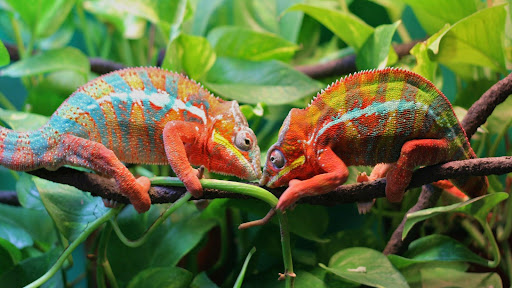If you want to keep a chameleon as a pet, you can choose from a wide range of types of chameleon. It’s no surprise that these famous reptiles are so appealing; they’re a delight to keep!
However, with so many different species to pick from, it can be difficult to know which is ideal for you. You could prefer one type of chameleon over another.
Happily, this guideline makes it simple to make a decision. We include all of the greatest sorts of pet chameleons so you can choose the one most appealing to you!
A Little About Chameleons
Chameleons are among the most intriguing species on the planet. They are skilled hunters, utilizing their unique tongues to catch food from great distances – catching prey that is more than twice their total length!
Chameleons’ extraordinary eyes, which can rotate in multiple directions and “zoom in” on prey like a long lens, are another unique characteristic. This isn’t just stunning; it distinguishes the chameleon from all other lizards.
Obviously, chameleons are well-known for their capacity to alter their color. Every chameleon species can change color to some point, however, some do it more spectacularly than others.
There are more than 150 species of chameleons known today, with many being discovered and identified.
Before we go any further, it’s worth noting that a large percentage of these taxons are not for purchase in pet shops or even specialized breeders. Several are only found in the wild, and it may even be prohibited to export them from their native areas.
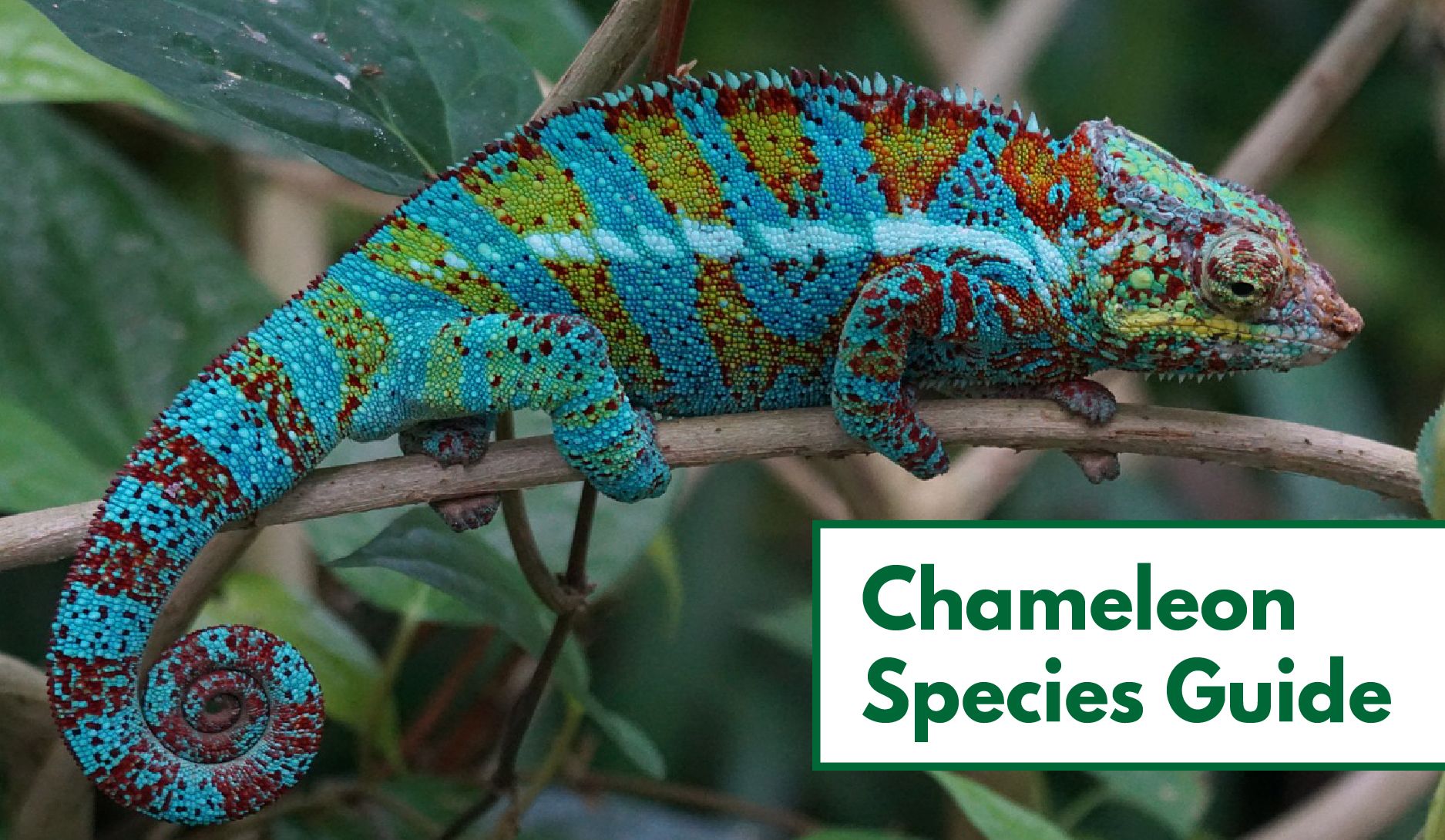
Continue reading if you’re looking to figure out which chameleon is ideal for you! We will discuss the 15 greatest varieties of chameleons to raise as pets, as well as their look, care requirements, and pricing.
Types of a Chameleon:
To make it easy for you we have divided the classification into different sections. Firstly we will look at chameleon species that are raised as pets. Following that, wild species will be classified by genus.
20 Types of Chameleon Species That You can Keep as a Pet
The below chameleon varieties are more likely to be found at a pet store or from a breeder. Each has its characteristics and features, and they all make terrific pets for reptile fans.
1. The Carpet Chameleon
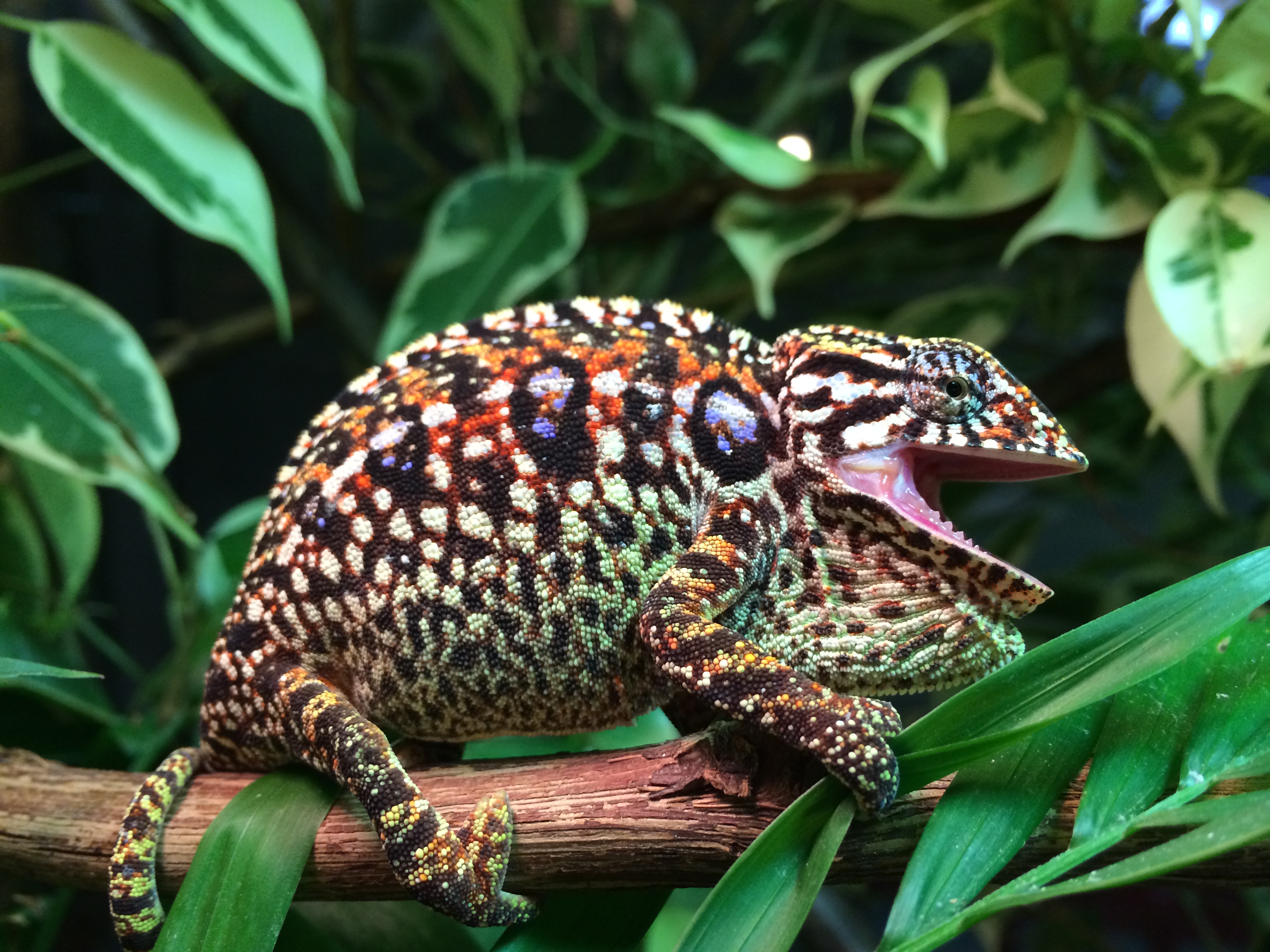
The Carpet chameleon (Furcifer lateralis) is a chameleon species unique to Madagascar’s deep woodlands. They are often timid and suspicious of others. Captive-bred chameleons, on the other hand, are typically more flexible in associating with their owners.
Carpet chameleons are named because of the carpet-like patterns and patterns on their bodies.
Adults, particularly females, are speckled with a variety of dots, rings, blotches, and lines.
Females have a dark green back, a creamy white abdomen, and reddish-gold edges. They are more appealing than men since they have more vibrant colors and designs.
Males and females typically grow to be taller than 10 inches, keeping them feasible.
Carpet chameleons are wonderful pets for both basic and advanced caretakers. They are not as huge as Oustalet’s or Parson’s chameleons, however, they are bigger than Senegal and pygmy chameleons.
2. Fischer Chameleon
Fischer’s Chameleon is a creature that scientists are currently researching about. Numerous chameleons in the pet industry nowadays are incorrectly identified as Fischer’s or Fischer’s subspecies.
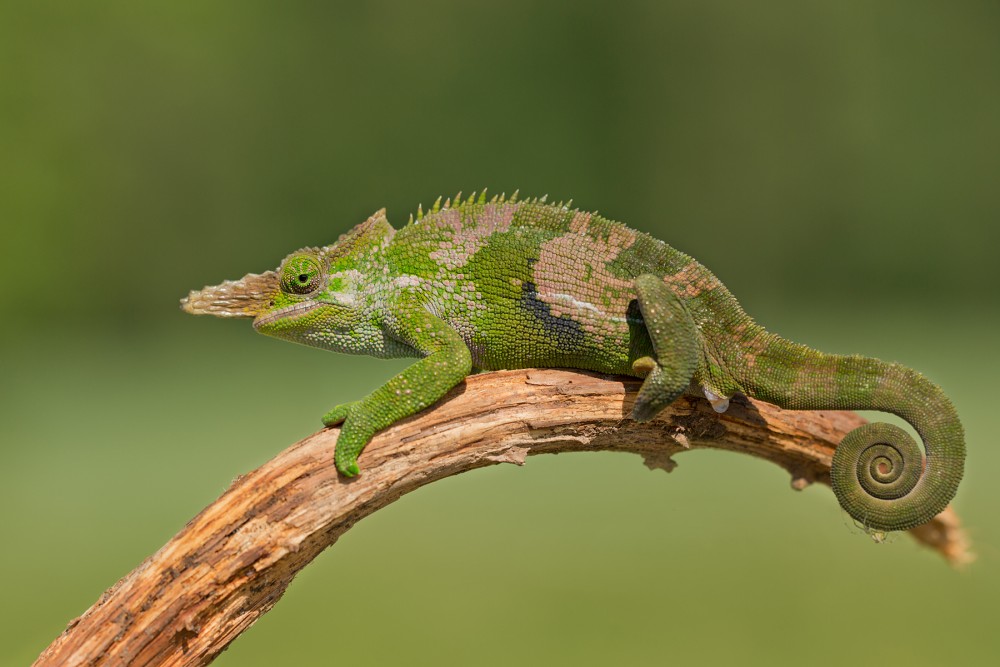
Genuine Fischer’s Chameleons, on the other hand, are extremely rare.
They are an appealing shade of green with a prominent nose-like feature that extends from the front of their faces. The species may reach a length of around 15 inches.
This species is a member of the relatively new genus Kinyongia.
3. Flap-Necked Chameleon
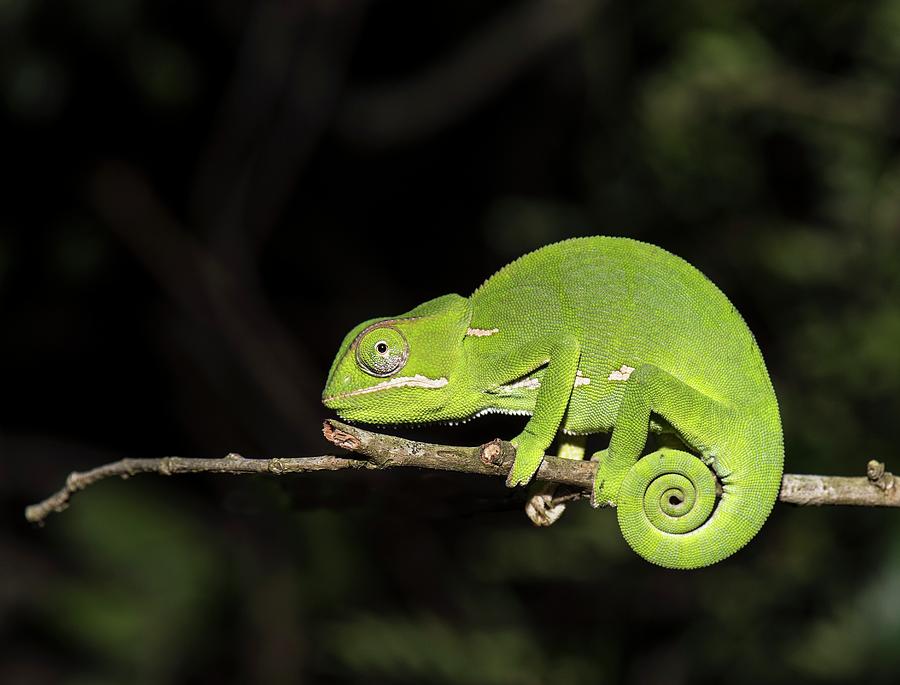
Flap-necked chameleons (Chamaeleo dilepis) are widespread in Sub-Saharan Africa’s woodlands, grasslands, and cities. In addition, they are commonly bred in captivity and marketed as pets.
Flap-necks are among the few chameleon types that can be managed since they are gentle, adaptive, and moderately friendly. They are a wonderful alternative for first-time home buyers.
These reptiles can easily be identified.
They feature a coiled tail, a triangular face, and camera-like eyes. This type is yellow-green with a faint creamy stripe on either side.
Flap-necked chameleons are classified into eight subspecies. The biggest can grow to be 14 inches long.
4. Jackson Chameleon(Three Horned Chameleon)
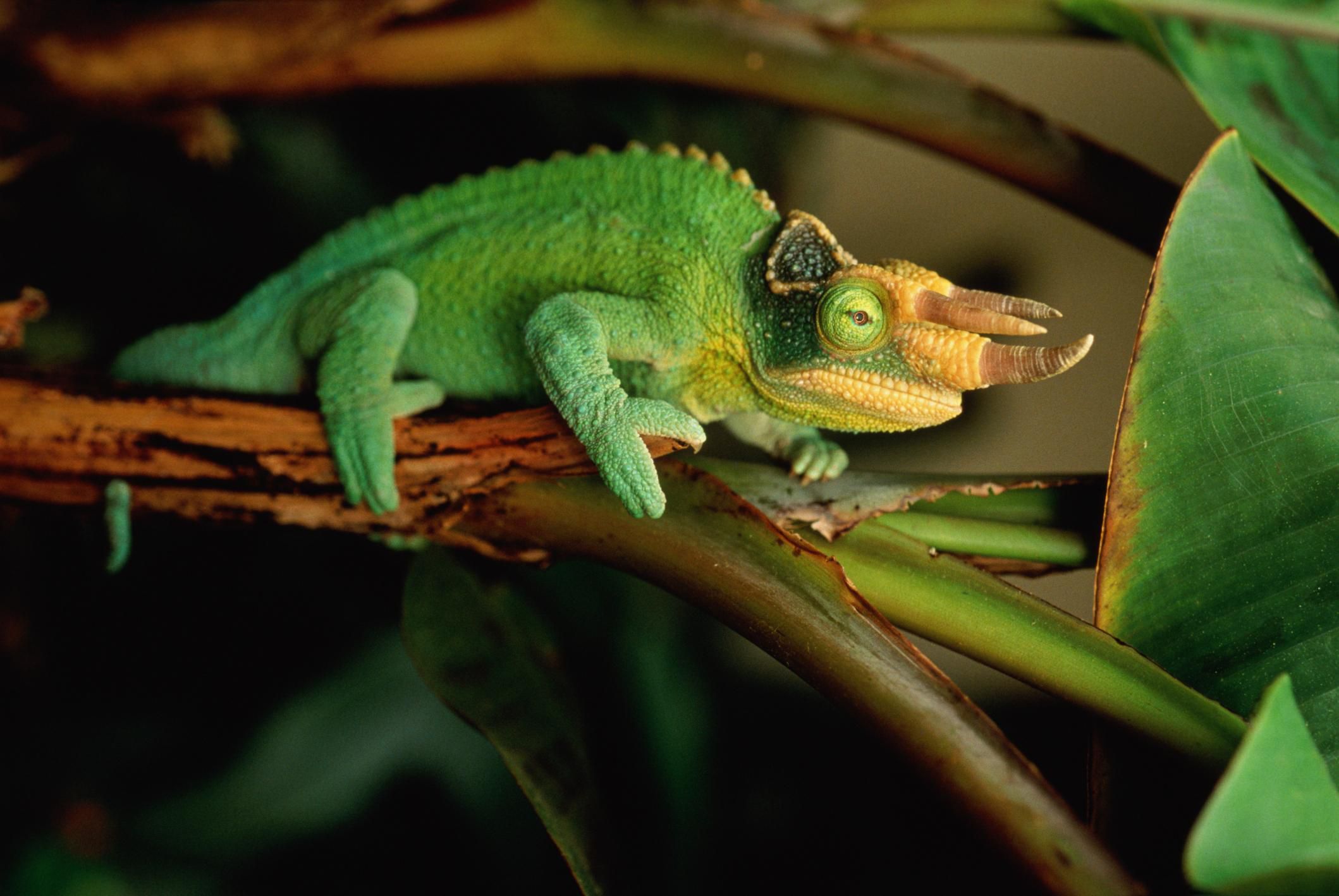
This species is native to East Africa, although it may also be found in the wild in Hawaii, where it was imported. They are distinguished by their “horns,” which may grow to be approximately 13 inches long and also have an 8-year lifetime.
This breed is widely accessible for sale as a pet, and it can be a delight to watch and look for. It is also a member of the relatively recent subgenus Trioceros.
5. Meller’s Chameleon

The Meller’s chameleon (Trioceros melleri) is a huge, robust, and eye-catching species native to eastern Africa’s highlands. Except for Madagascar, this is Africa’s biggest native chameleon. Adults can grow to be over 2 feet long and weigh a pound or over.
Meller’s chameleons are sometimes known as huge one-horned chameleons.
On the ends of their noses, both men and females grow a big, spherical horn.
This species is often a beautiful deep green with white stripes and a pointy nose-like protrusion on its face. Meller’s are considered to be quite violent, and they often fare poorly when housed alongside other lizards. This chameleon, like its three and four-horned siblings, is a member of the Trioceros sub-genus.
6. Panther Chameleon
The panther chameleon (Furcifer pardalis) lives in Madagascar’s tropical forests. These lizards are well-known for their extroverted personalities and striking colors. Particularly colorful species might fetch $500 or maybe more.
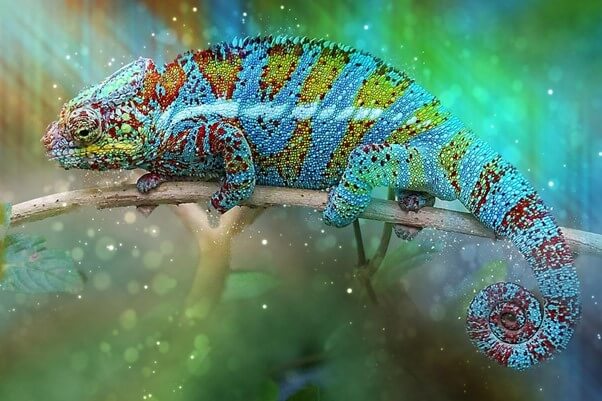
Panthers are moderate to big lizards that come in a variety of colors including red, greenish, blues, and yellow. They can shift hues, but it takes many moments for this to happen.
Males can reach 20 inches in length, but females seldom exceed 12 inches. These lizards feature a single harsh horn on their nose, a little head crown, and bright stripes and patches.
Panther chameleons are one of the simplest chameleon species to care for in captivity. They are, nevertheless, rather difficult for a beginner.
7. Veiled Chameleon
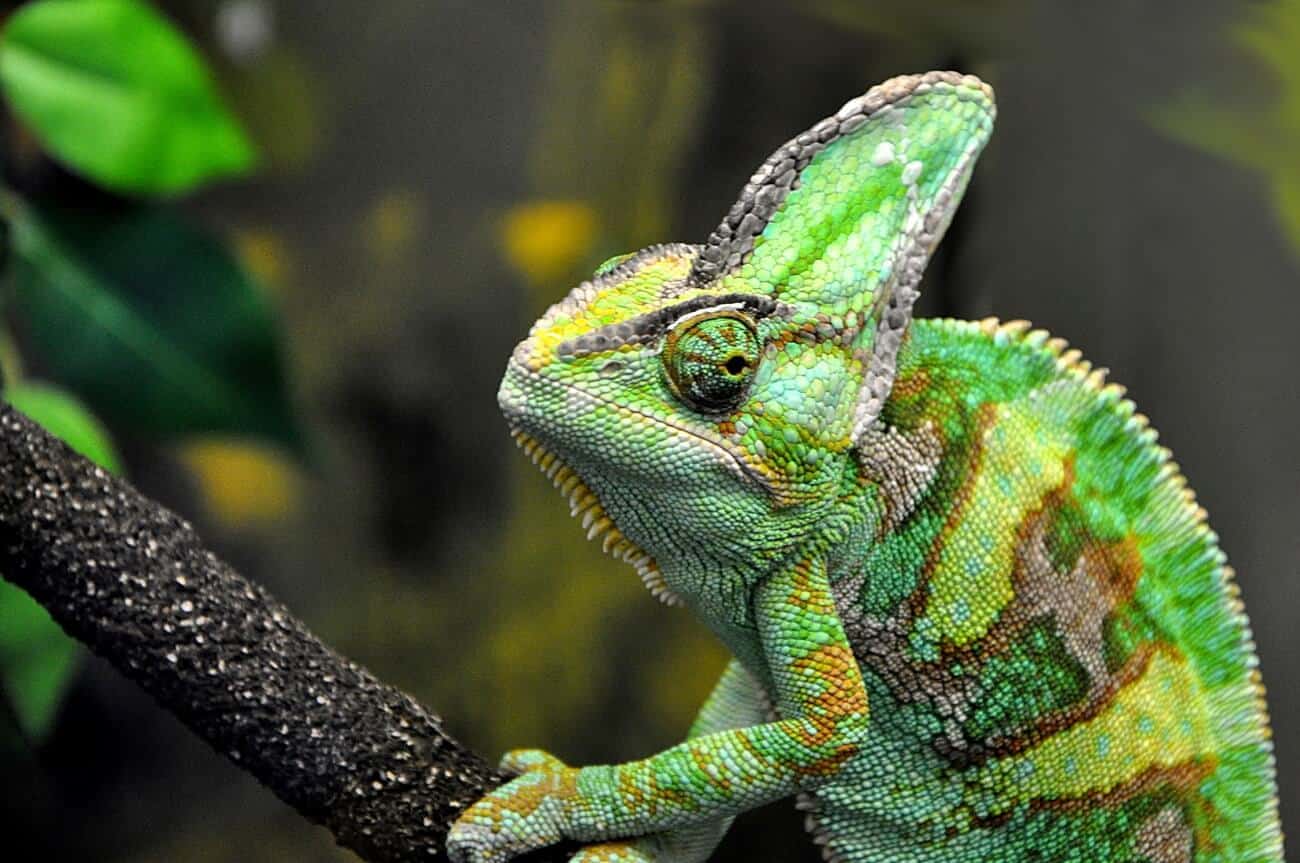
Without even any hesitation, Veiled Chameleons are among the most famous ones in the reptile market as well as great pets. This is due in great part to their simplicity of maintenance and lovely color.
The body is often coated in yellow, greenish, and brown patterns. However, like many chameleon species, this one may change color on the fly. These reptiles are noted for their vibrant colors!
8. Outstalet’s Chameleon
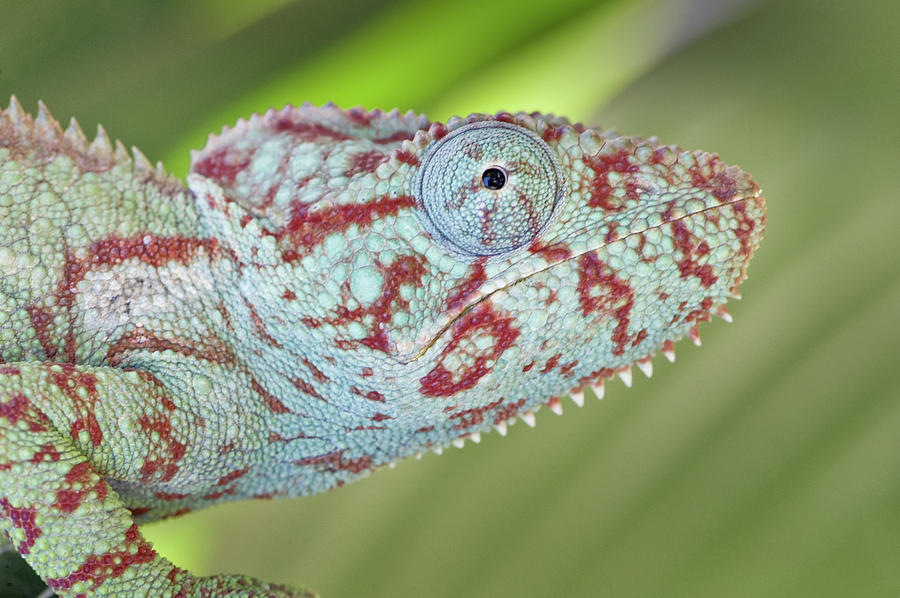
The Outstalet’s chameleon (Furcifer oustaleti) is one of Madagascar’s most colorful and biggest species. They inhabit the outskirts of jungles, woodlands, and communities. Oustaleti is classified as exotic species in Florida.
Females are normally significantly smaller than males and can grow to be 27 inches long. Gray, brown, and greenish are prevalent hues in this species. Red, white, and black stripes are also prevalent on their body.
If you’re considering keeping a chameleon as a pet, make sure you buy or build a massive enough cage to fit this magnificent creature.
9. Four-Horned Chameleon
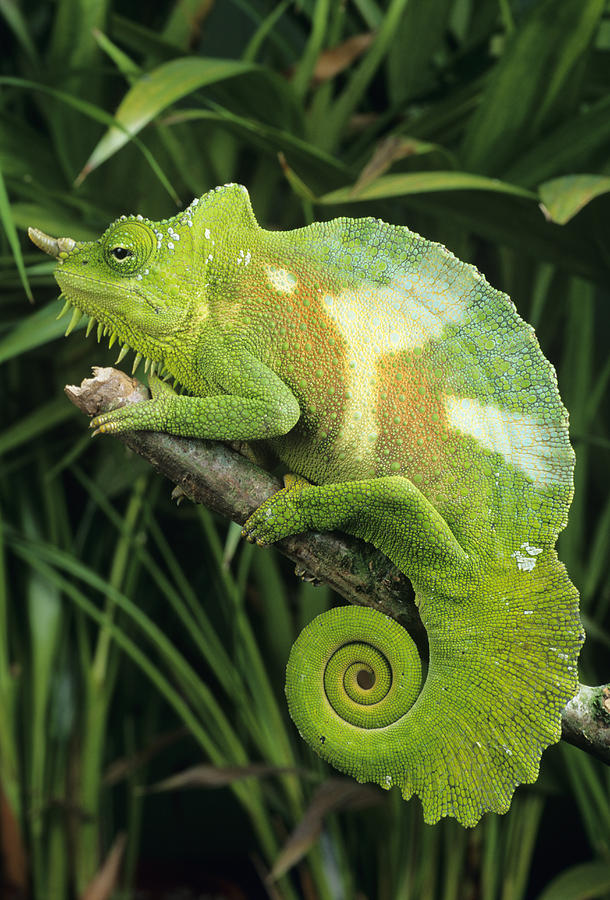
The Four Horned chameleon, which is native to Cameroon, is also known as the Cameroon chameleon or indeed the “quad.” This catamaran species, which may grow to be 10-14 inches in length, is usually found in forests.
It is green with varying squamation, with violet or bluish accented hues on occasion.
This species is distinguished by its enormous beard and the horns that carry its name. Unfortunately, these lizards do not always have exactly four horns and can have somewhere from one to six.
The Four-Horned Chameleon was once classified as a member of the genus Chamaeleo, which was correct. Yet, it is presently classified as a member of the species Trioceros, which is a subgenus of Chamaeleo.
10. Transkei Dwarf Chameleon
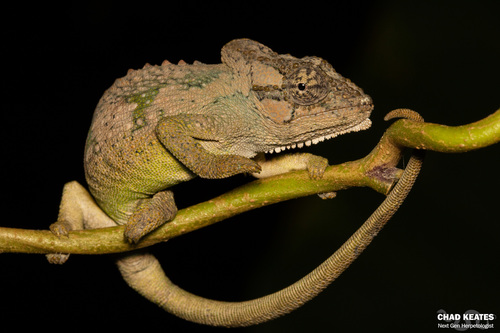
This chameleon, commonly known as the Pondo dwarf, is native to South Africa’s Eastern Cape area. This variety is nearly totally restricted to Port St. Johns. The Transkei is threatened by habitat loss.
11. Knysna Dwarf Chameleon
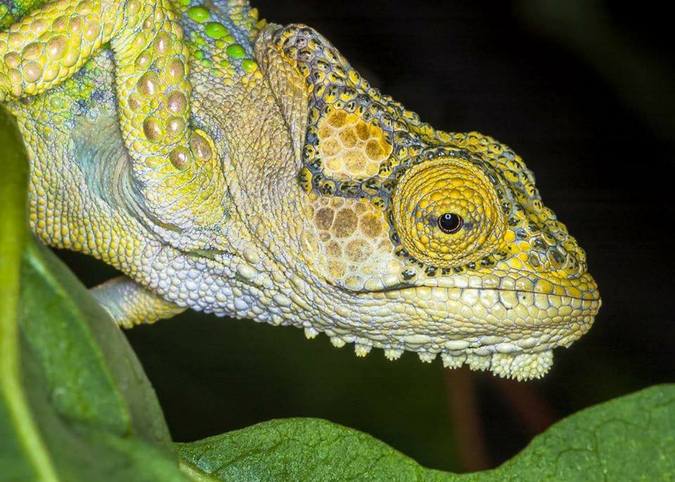
The Knysna dwarf chameleon has the longest tail in the Bradypodian species and may reach up to 7 inches long. It also has a large casque.
This species’ skin color often ranges from brilliant green to blue, with purple, yellow, and sometimes pink skin patterns.
The Knysna Dwarf Chameleon, like other chameleons, has the astonishing capacity to modify colors at will. However, it differs from other lizards in one additional way. Individuals of this species, unlike others of its kind, give rise to living offspring rather than laying eggs.
12. Drakensberg Dwarf Chameleon
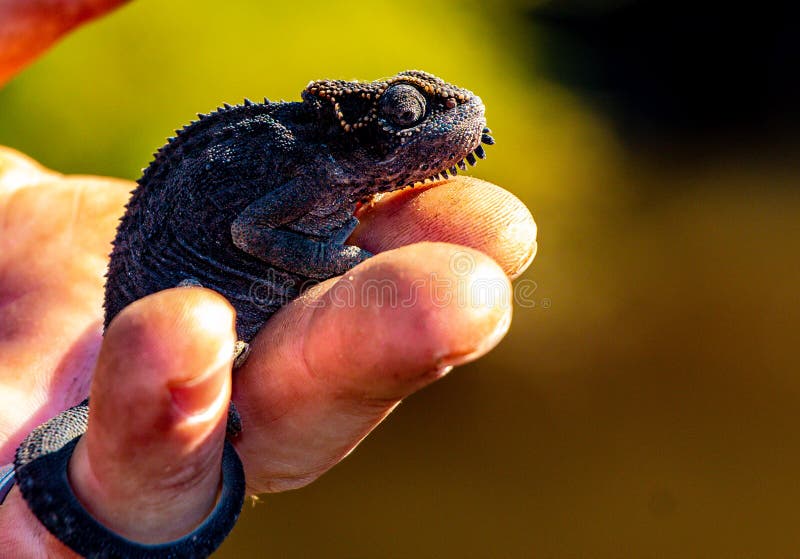
Apart from vivid blue-green trabeculae (tiny blemishes) on its top limbs and sides, this little chameleon is normally light brown in appearance. It will occasionally show some light blue coloration on the tops of its cheekbones and the front of its head.
13. Dwarf Chameleon Robertson
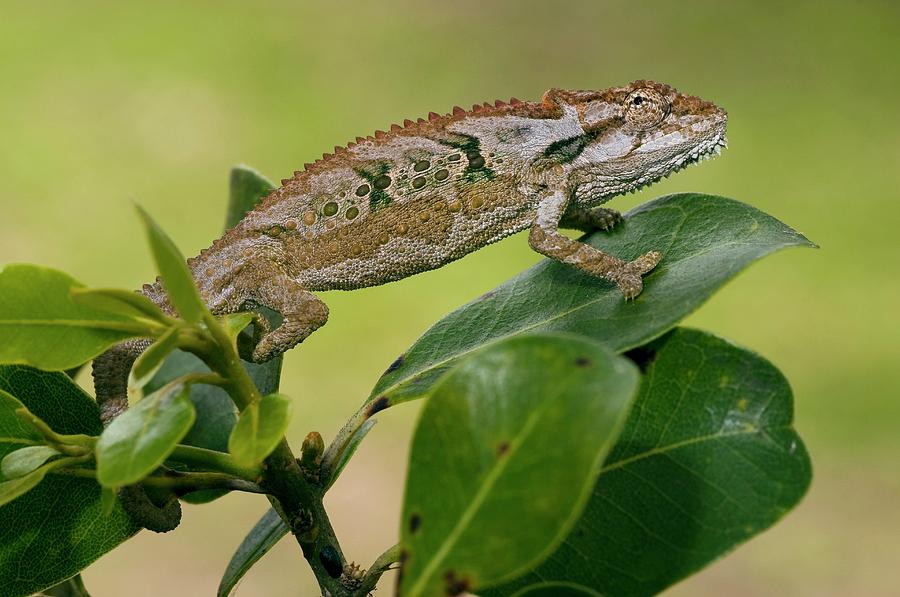
This standard size dwarf chameleon, sometimes known as the Little Karoo, reaches no bigger than six inches. This species is found in the Western Cape area and is often gray or olive in appearance. Apart from its forest-dwelling siblings, Robertsons feed on South Africa’s plentiful low-growing fynbos bushes. Some research shows that the Robertson separated from the forest-dwellers thousands of years ago, altering its diet when the woods retreated and gave place to the arid forest.
14. Black-Headed Dwarf Chameleon
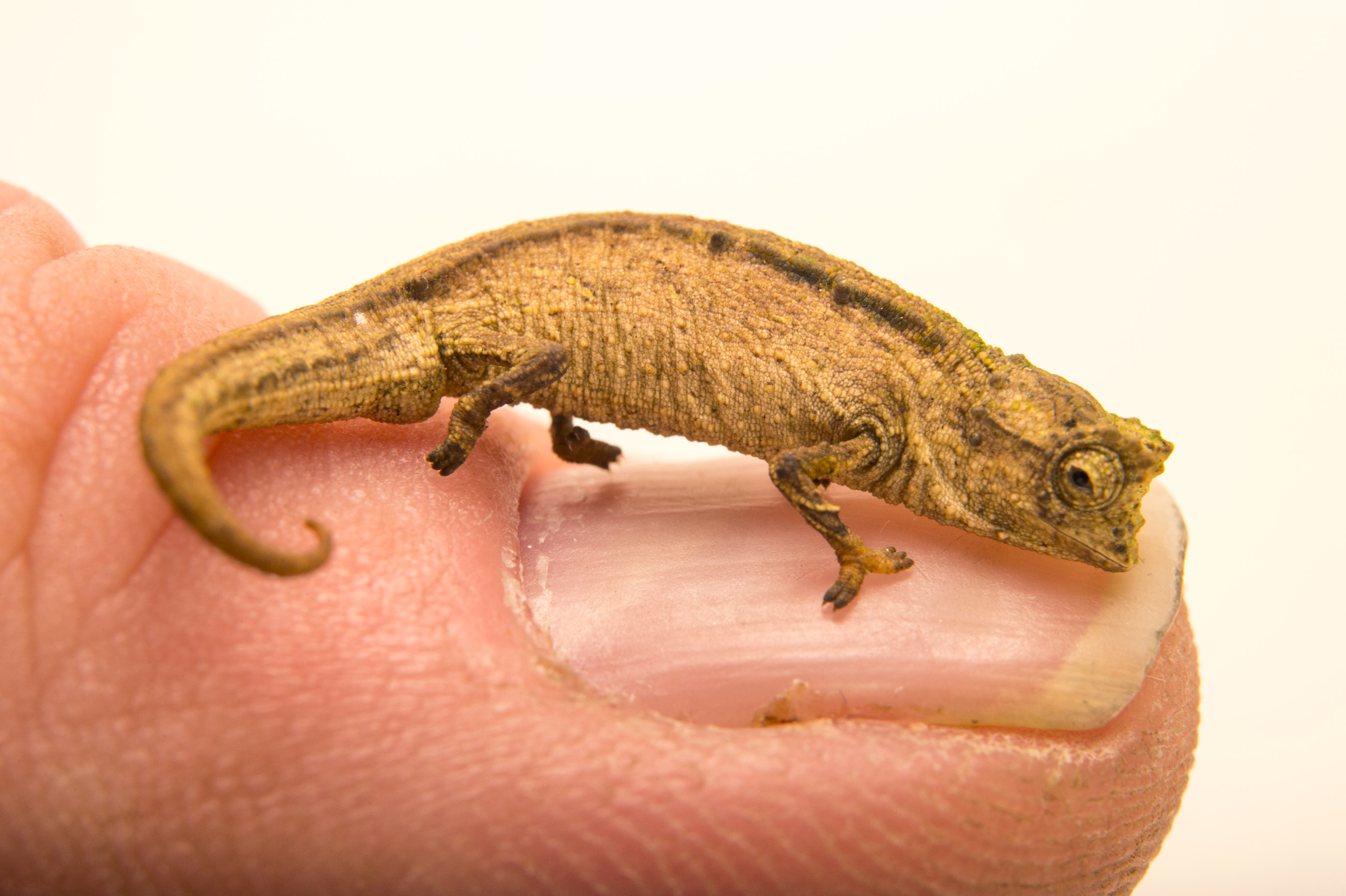
This species can be found in KwaZulu-Natal, South Africa, and is also known as the KwaZulu dwarf chameleon. They have brownish bodies and darker-colored heads. Despite its name, Black-Headed dwarfs do not have completely blackheads.
15. Cape Dwarf Chameleon
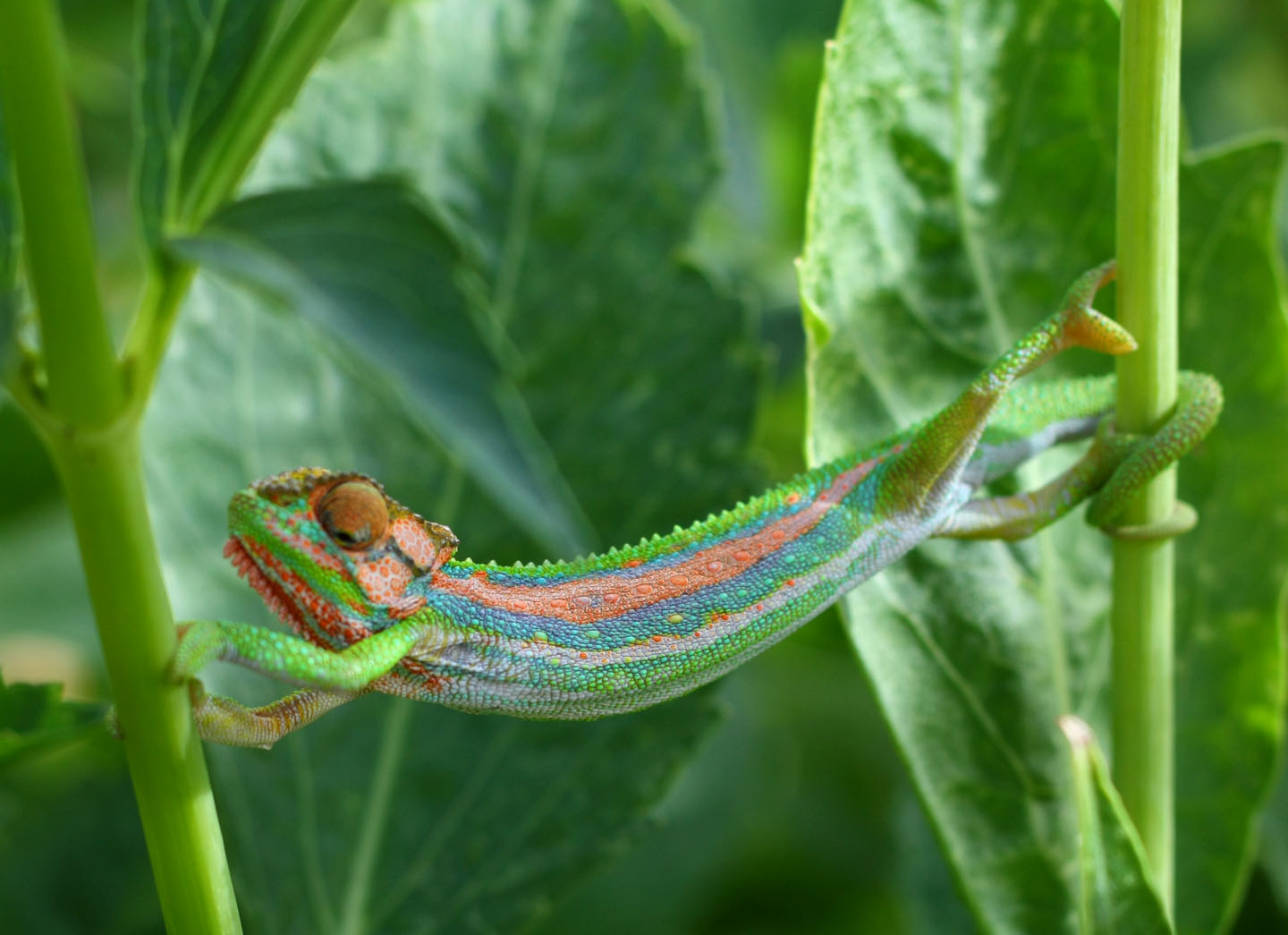
The body and head of this variety are predominantly green with orange patterns. Males have a richer green color, whilst females have a muddier green color. This is a chameleon type that gives birth to live young instead of depositing eggs.
16. Dwarf Chameleon Setaro
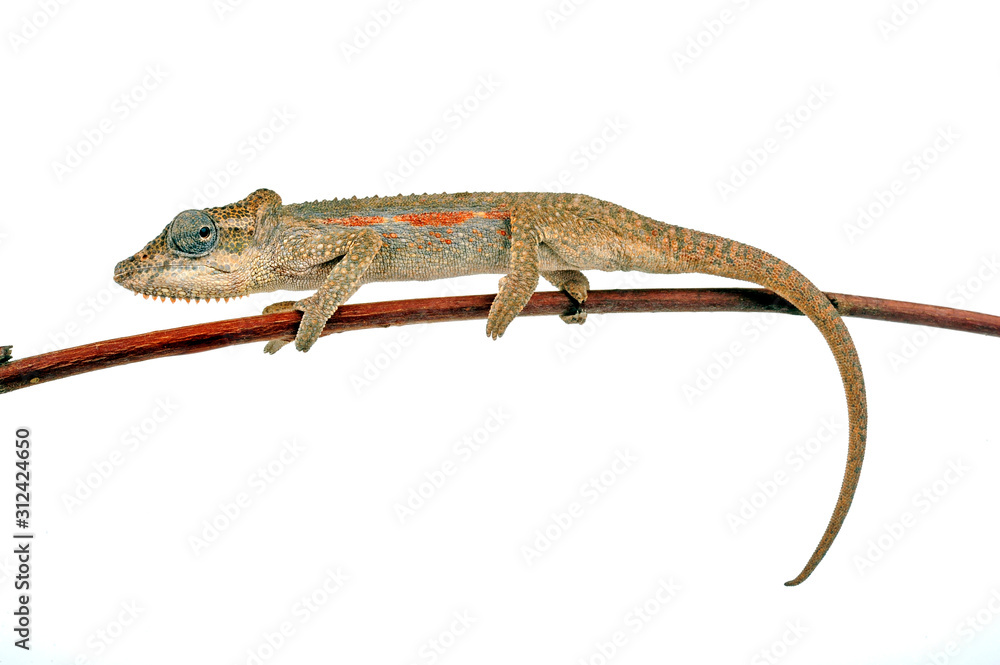
Setaro’s variations are among the smallest dwarf chameleons, reaching little more than 4 inches in length. In addition, they have a lower neck crest than other types.
17. Smith’s Dwarf Chameleon
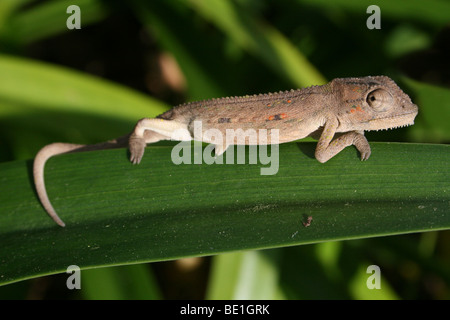
This African dwarf lizard is one of the kinds that utilizes its color-shifting ability to hide in places.
18. Natal Midlands Dwarf Chameleon
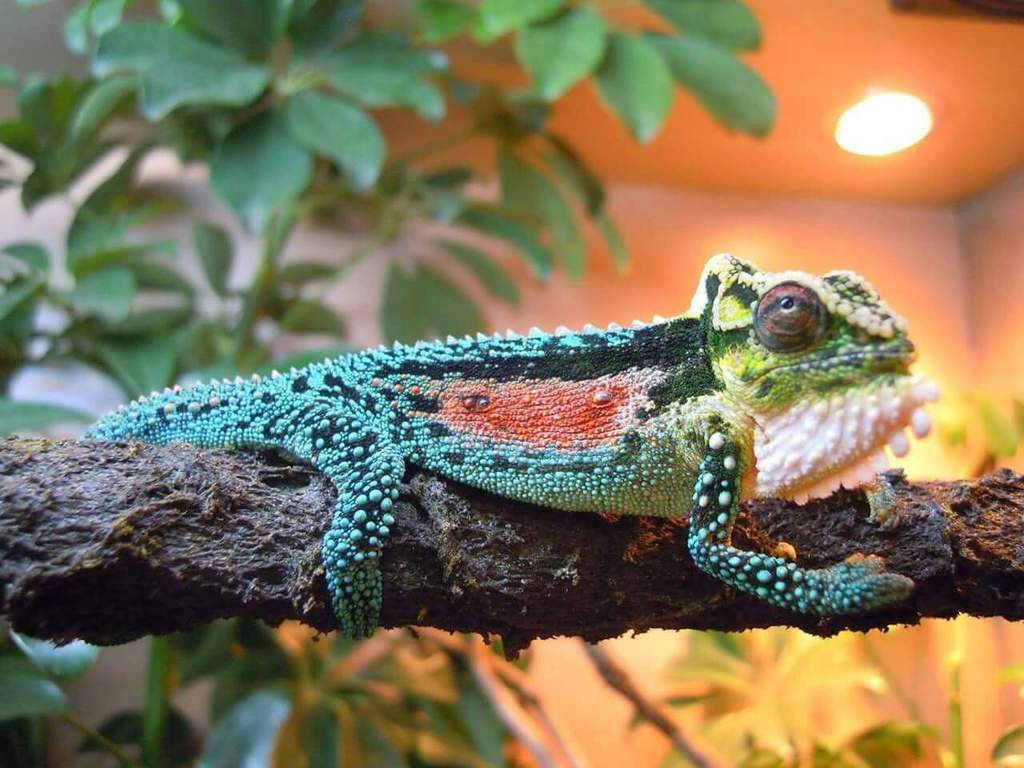
This is a little dwarf chameleon that is similar to the Black-Head dwarf.
The Natal Midlands variant barely reaches a length of around 3 inches. It has multicolored squamation all over its skin. It has a golden crest on its head and a white neck. The orange streak produced by males significantly distinguishes this species.
19. Dwarf Chameleon Transvaal
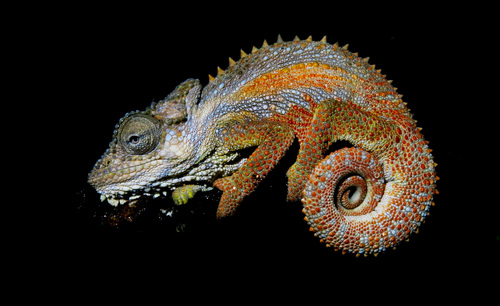
This variety is native to South Africa and Swaziland, and it is typically observed in wooded environments at higher altitudes on hills or peaks.
Transvaal may also be found in shallow valleys and are notable for their vibrant hues, which frequently exhibit beautiful reds and oranges.
20. Dwarf Chameleon Namaqua

The Namaqua dwarf, also known as the Western dwarf chameleon, tends to reside among coastal plants on Namibia’s and South Africa’s west coasts. This type is fairly big for the genus, reaching lengths of more than six inches. The Namaqua is also broader and has a short tail.
Namaqua is often a drab brownish or gray tint with considerable blotchy skin. The pattern of lines that runs over their chins is a distinctive characteristic of this species.
Chameleon Genus Species
Chameleons in the Chamaeleo genus have all of the most distinguishing chameleon traits, such as the twisting prehensile tail. Chamaeleo is the genus name of the majority of pet chameleons on the marketplace currently.
1. Two-Lined Chameleon
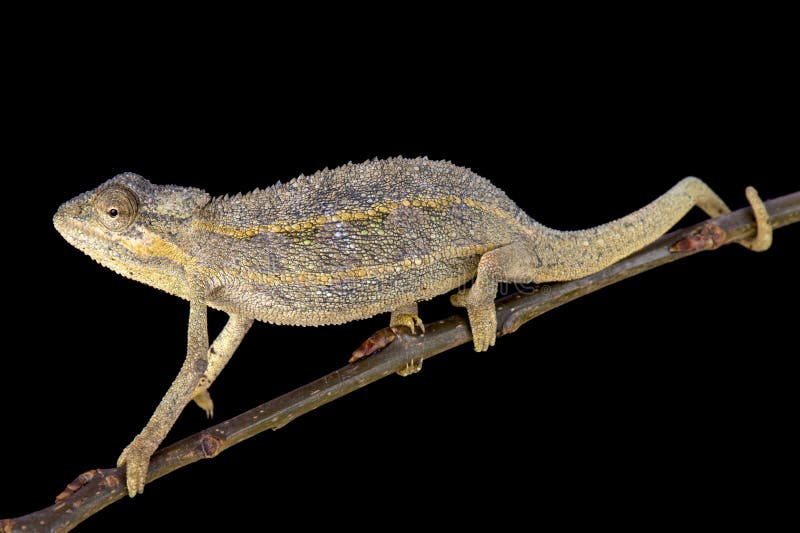
This species, sometimes known as the Two-Striped or side-striped chameleon, is found only in Sudan, Ethiopia, Somalia, Kenya, and parts of the Democratic Republic of the Congo.
It is usually brownish in appearance, with a series of fragmented white stripes running down either side of its body.
2. Veiled Chameleon
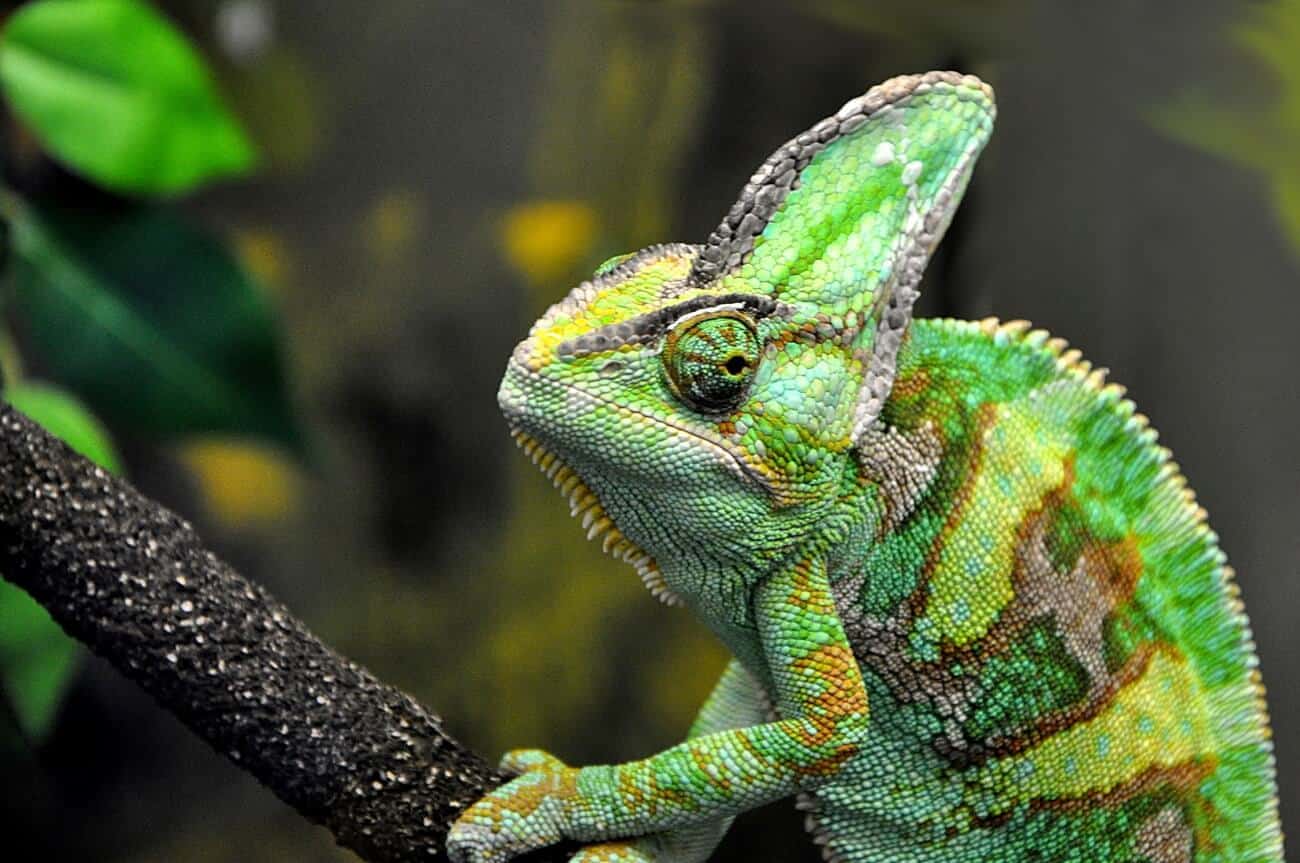
Veiled chameleons, sometimes known as Yemen chameleons, may grow to be quite huge – up to 2 feet! The name of this species comes from the crown on top of its head. It is also well-known for its vibrant patterns.
The Veiled Chameleon is a popular breed for reptile lovers and may also be spotted in the wild. In reality, the Veiled chameleon may be found throughout Africa.
3. Jeweled Chameleon
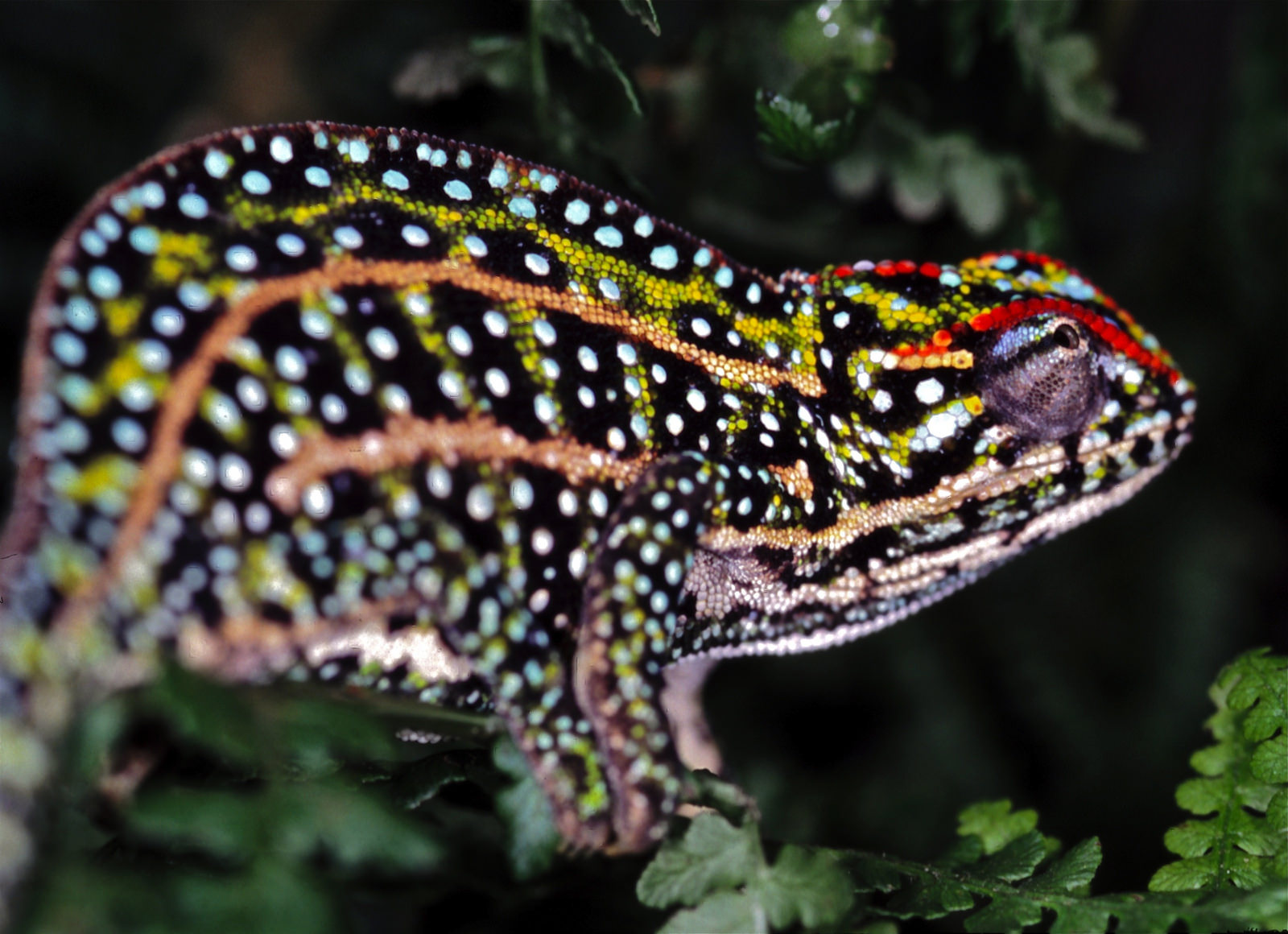
This is a little reptile that is also known as the Madagascar Forest chameleon and Campan’s chameleon. It grows nearly5 inches. The Jeweled chameleon, which lives in Madagascar’s central highlands, is classified as a vulnerable species owing to habitat degradation.
The Jeweled chameleon is noted for its remarkable look. It is generally of some dark green with dorsal striping and gorgeous bright-color spots.
4. Common Chameleon
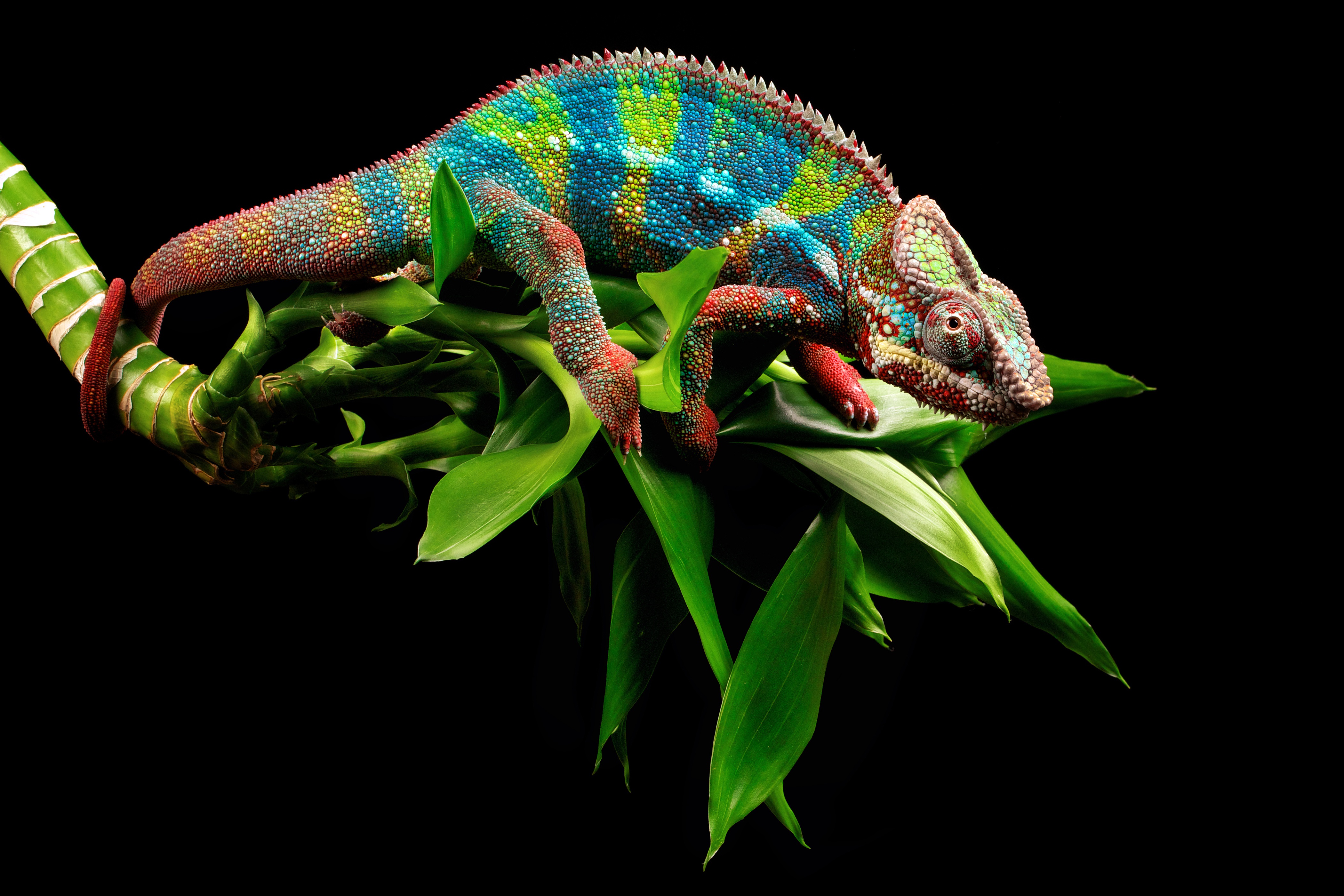
The common chameleon is the only chameleon genus found in Europe, and it is endemic to areas such as southern Portugal.
This species is generally greenish, greenish-yellow, or brown and may be found among shrubs and trees in bushland environments.
It possesses an opposable tail and four-toed paws for grasping the branches and stems it crawls on.
5. Giant Three-Horned Chameleon
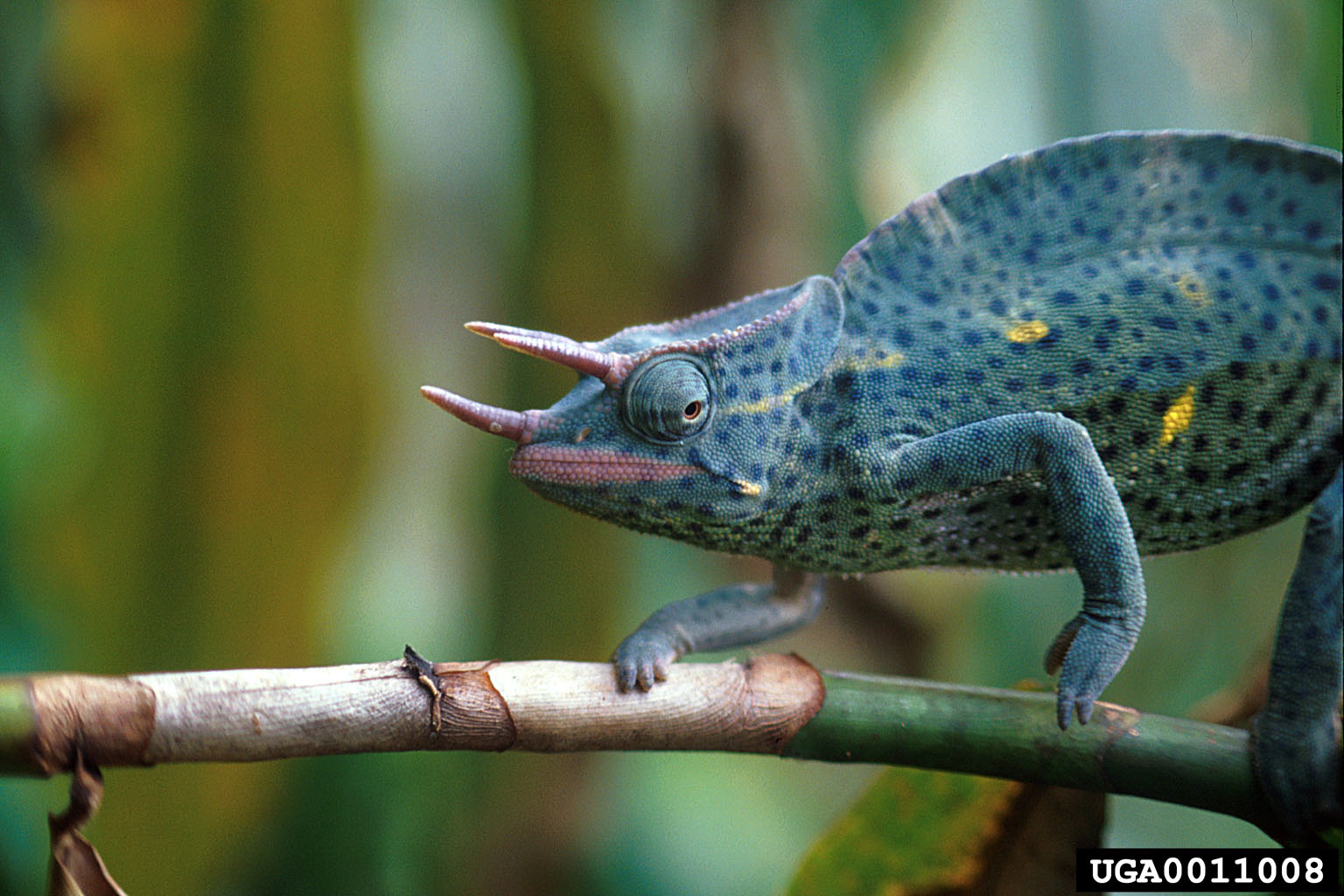
The Giant Three-Horned Chameleon is enormous and has three horn-like features projecting from its forehead, as the name suggests. This species is native to East Africa, but it has been brought to Hawaii, Florida, and California.
6. Graceful Chameleon
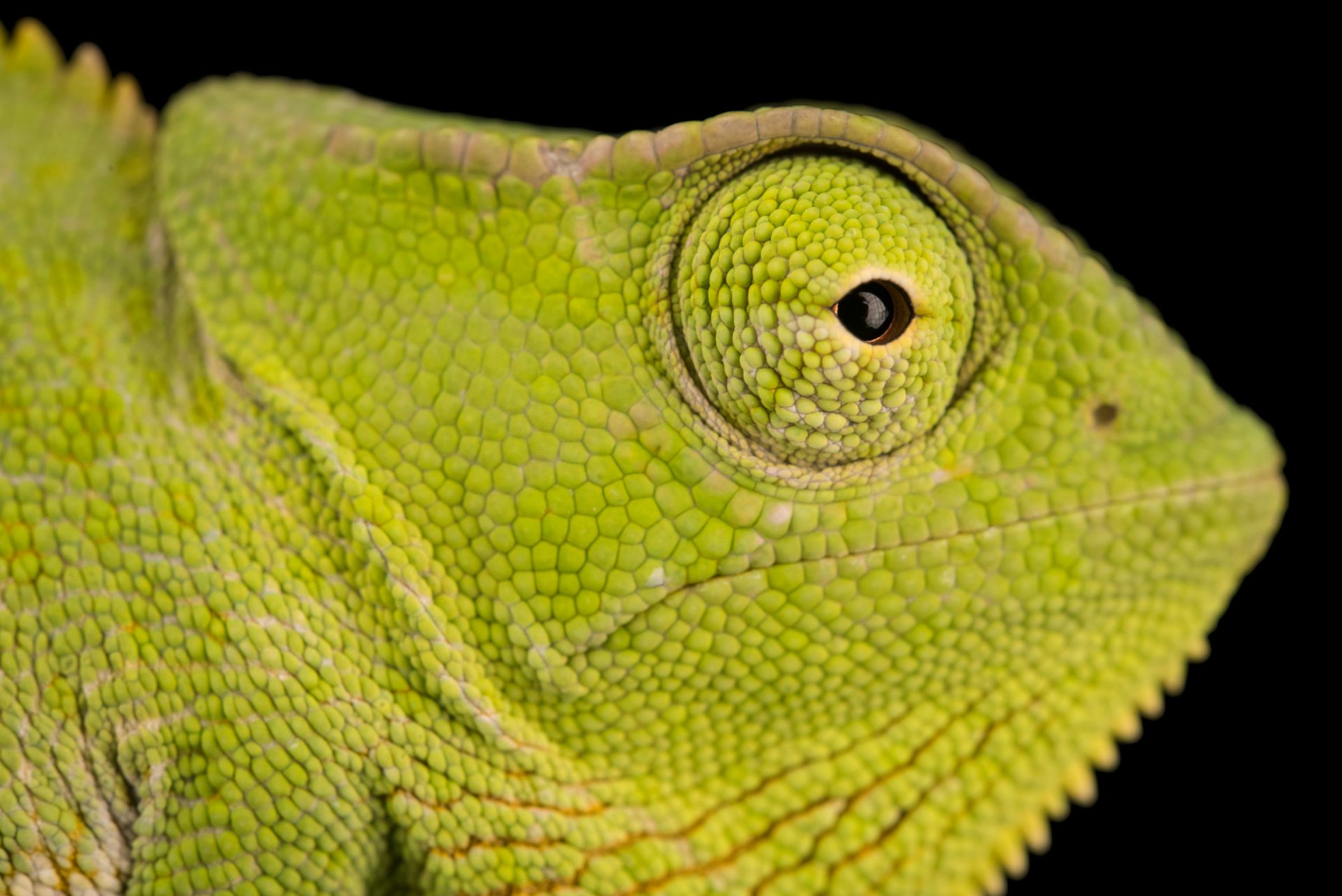
The Graceful chameleon is located in Central Africa and varies in hue from greenish to yellow to brown. They may reach a length of 15 inches and also have a green stripe spanning the entirety of their bodies.
Males genus of it are often incredibly aggressive and exhibit spectacular color changes when attacked. Females will have yellow or orange patches while they are looking for a mate.
7. Elephant-Eared Chameleon
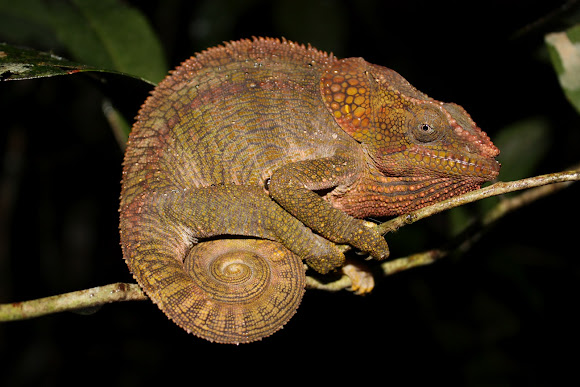
This species, sometimes referred to as the Short-Horned Chameleon, has enormous frontal lobes that mimic gigantic ears. Males have a small, bony extension that arises from their snout.
Their color ranges from a dreary gray to vibrant blue and green.
There is a lot of diversity amongst Elephant-Eared chameleons discovered in different places, including significant size variances, which has led some experts to assume that this species is made up of multiple strongly linked – but distinct – species.
8. High Casqued Chameleon
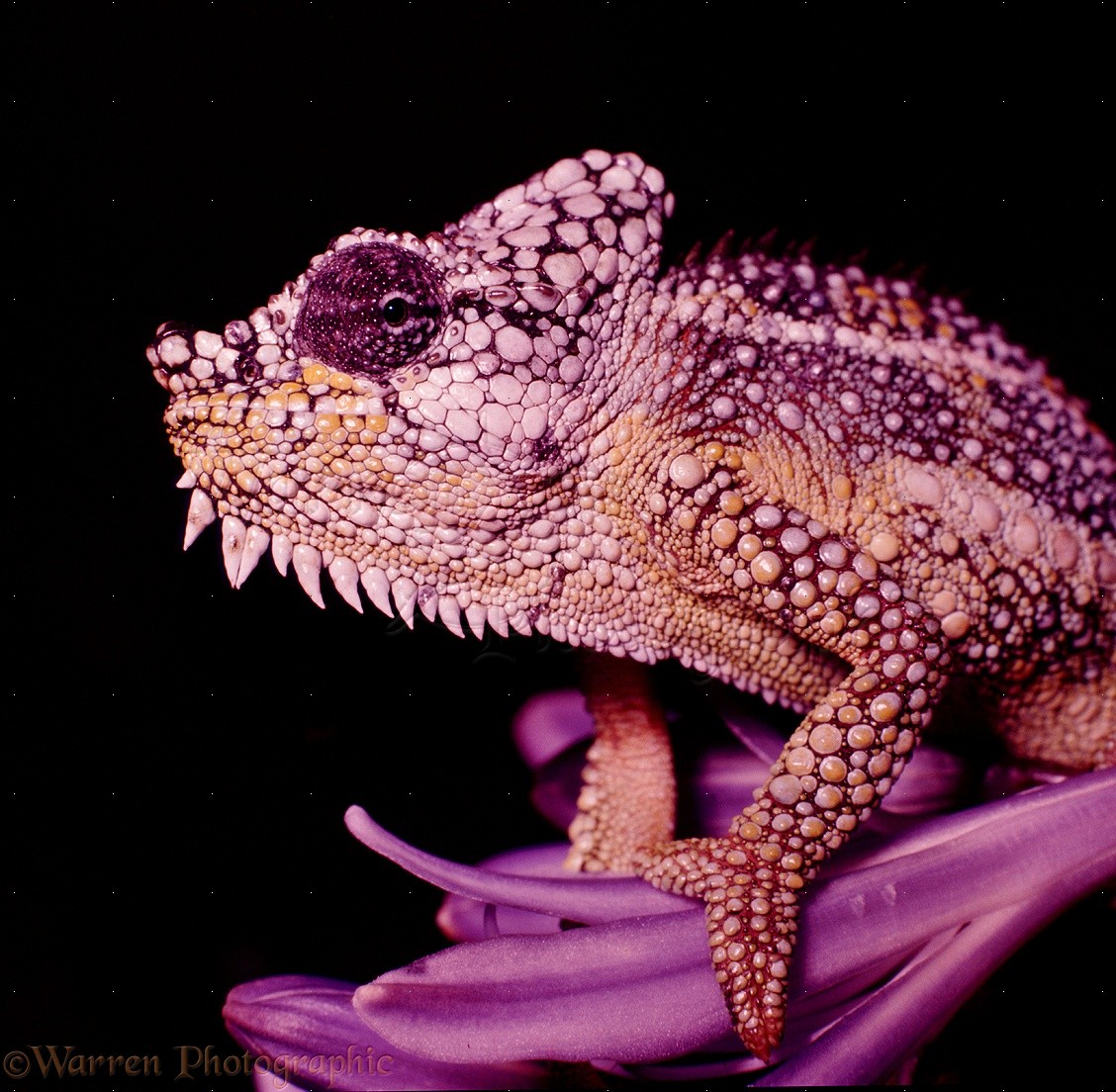
The Helmeted chameleon and Von Hoehnel’s chameleon are two names for this variety of chameleon.
They may be found in the wild all over eastern Africa. This is a small-medium chameleon that grows to be around 10 inches long when mature. This variety comes in a broad range of color variants.
They have a single horn, a spiny neck crest, and a notched back crest.
9. Johnston’s Chameleon
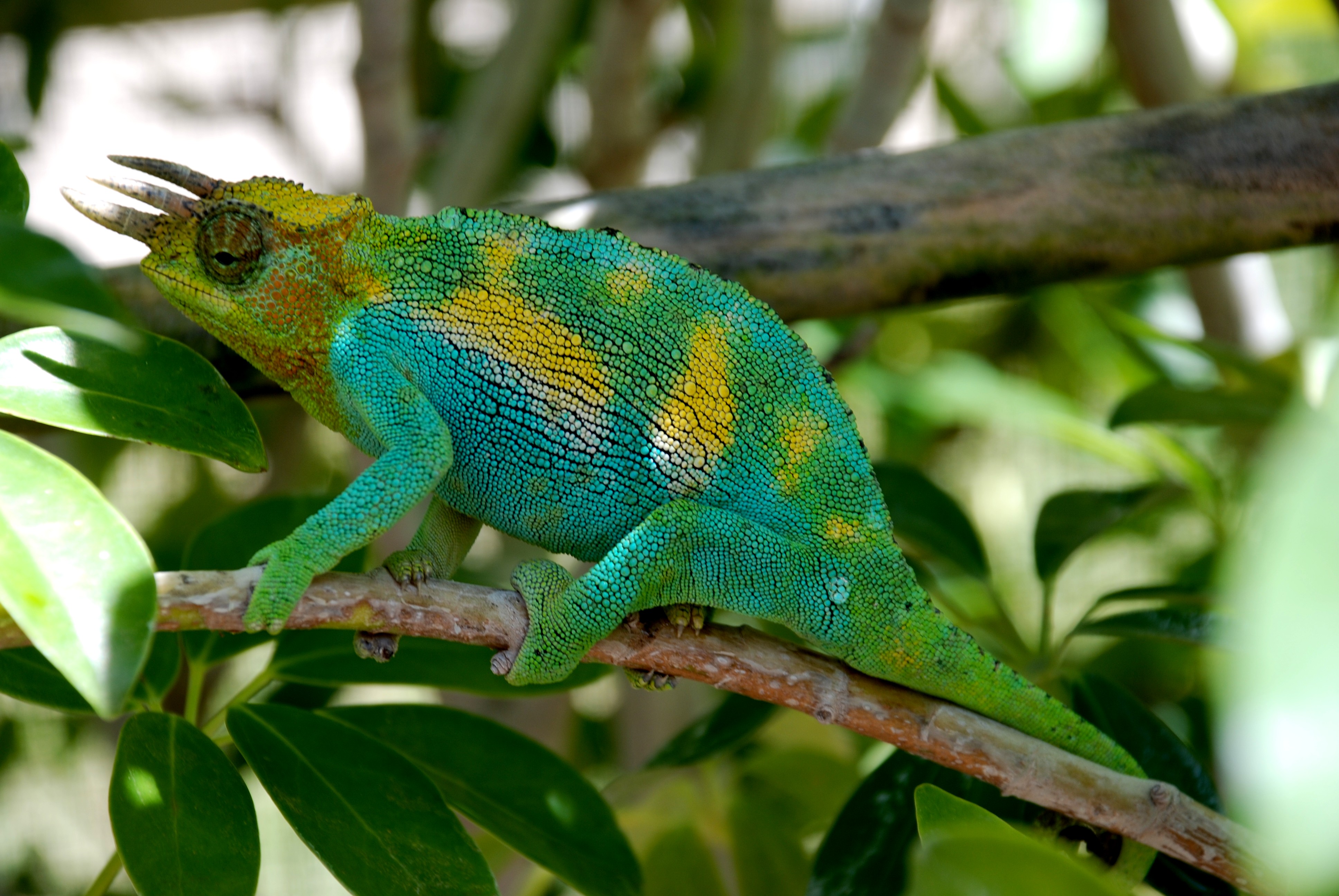
The Johnston’s chameleon, another three-horned species, is also known as the Ruwenzori chameleon. Its natural range includes Uganda and Rwanda.
Even if they are occasionally offered as pets, they are not as common as most other pet chameleon types.
10. Cameroon Sailfin Chameleon
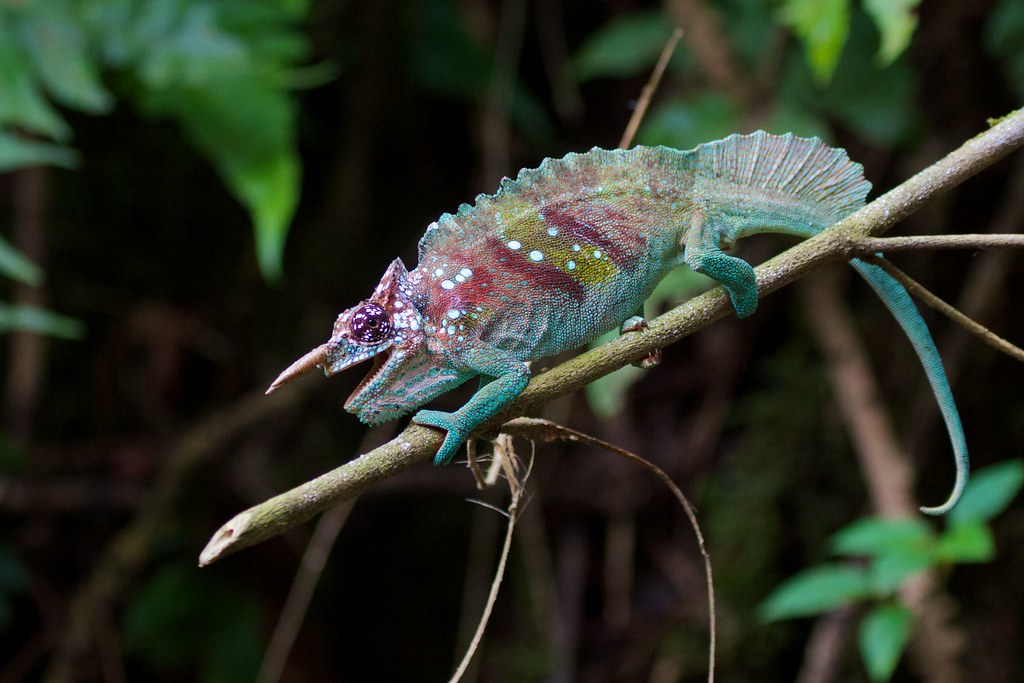
This genus, also recognized as the Cameroon two-horned Mountain Chameleon, is found solely in forests in the Cameroon highlands at elevations.
They have been observed migrating to surrounding farms and orchards. This type, which is usually green, has two big horns and a huge frontal sail.
11. Owen’s Chameleon

This species is confined to Sub-Saharan Africa and is also known as Owen’s three-horned Chameleon. Adults have three horns and crests. This is a rather huge species that may grow to be about a foot long.
12. Pfeffer’s Chameleon
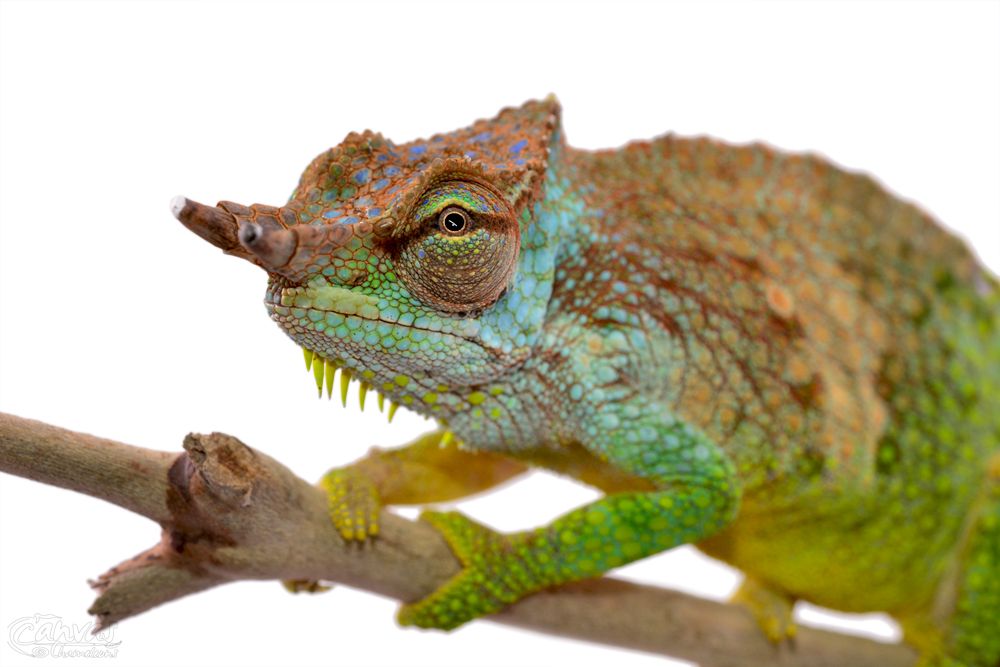
The Pfeffer’s chameleon is only found in Cameroon’s mountains. There are presently less than a dozen identified occurrences of this species around the globe, all of which are hidden in woodland areas.
The Cameroonian government protects remnant communities from captivity or slaughter due to continued forest destruction.
13. Senegal Chameleon
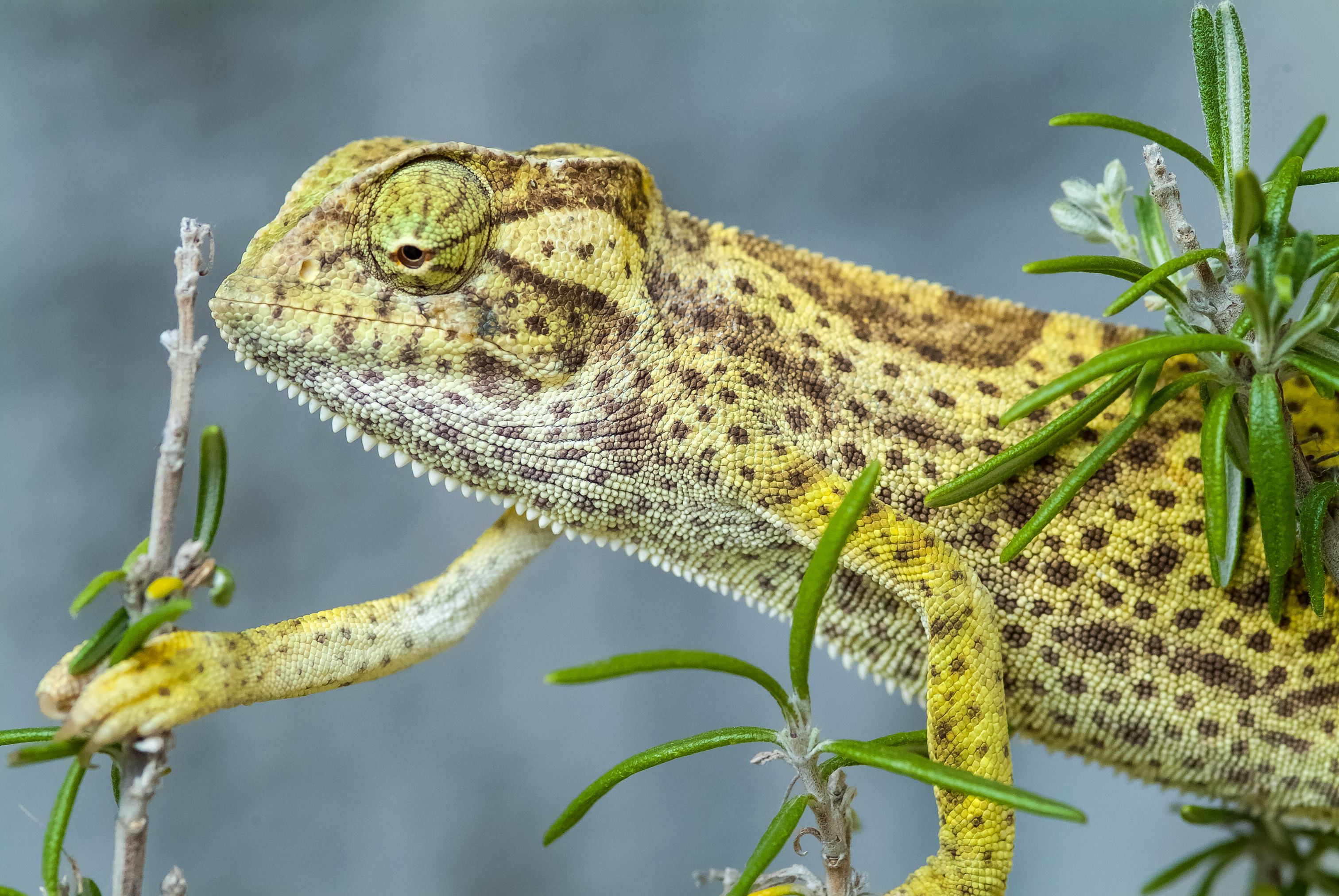
Nigeria, Cameroon, Mali, as well as Senegal, are all home to this genus. It is normally olive in color and around 9 inches long. The female of this species is often bigger than the male.
14. Werner’s Chameleon

Werner’s chameleon is a brownish-green chameleon native to the woods of Udzungwa and the highlands of Tanzania’s Eastern Arc.
They typically reach a length of around a foot and feature a unique merged occipital lobe. Males have three annulated horns on each side of their skulls. Females only have one.
15. Tiger Chameleon
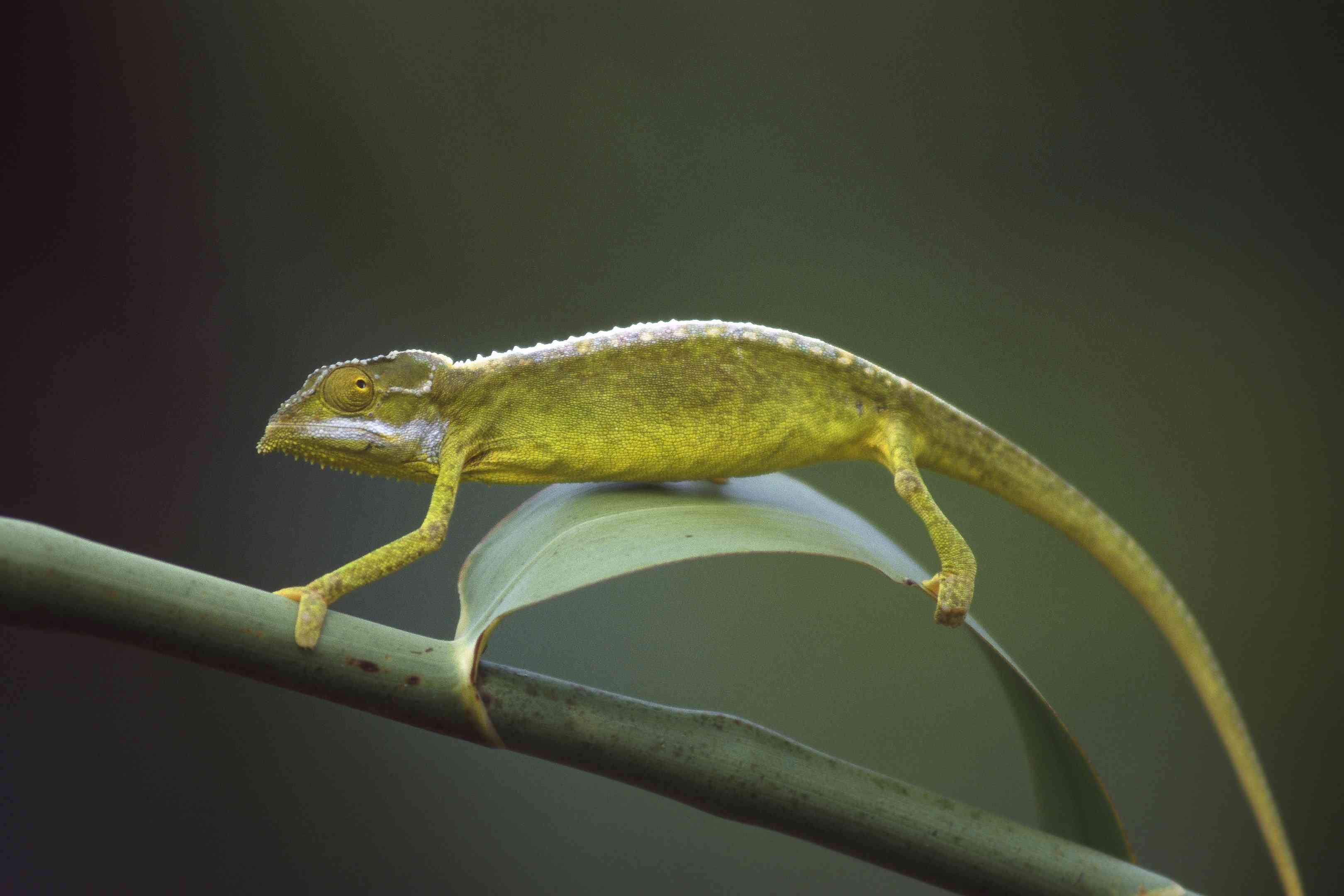
In maturity, the Tiger chameleon grows to be approximately six inches in length and comes in a variety of hues, including grayish, orange, greenish, and brown.
The collection of peaks on its face and the long, pointed projection on its chin is its most noticeable traits.
16. Chameleon Rhinoceros
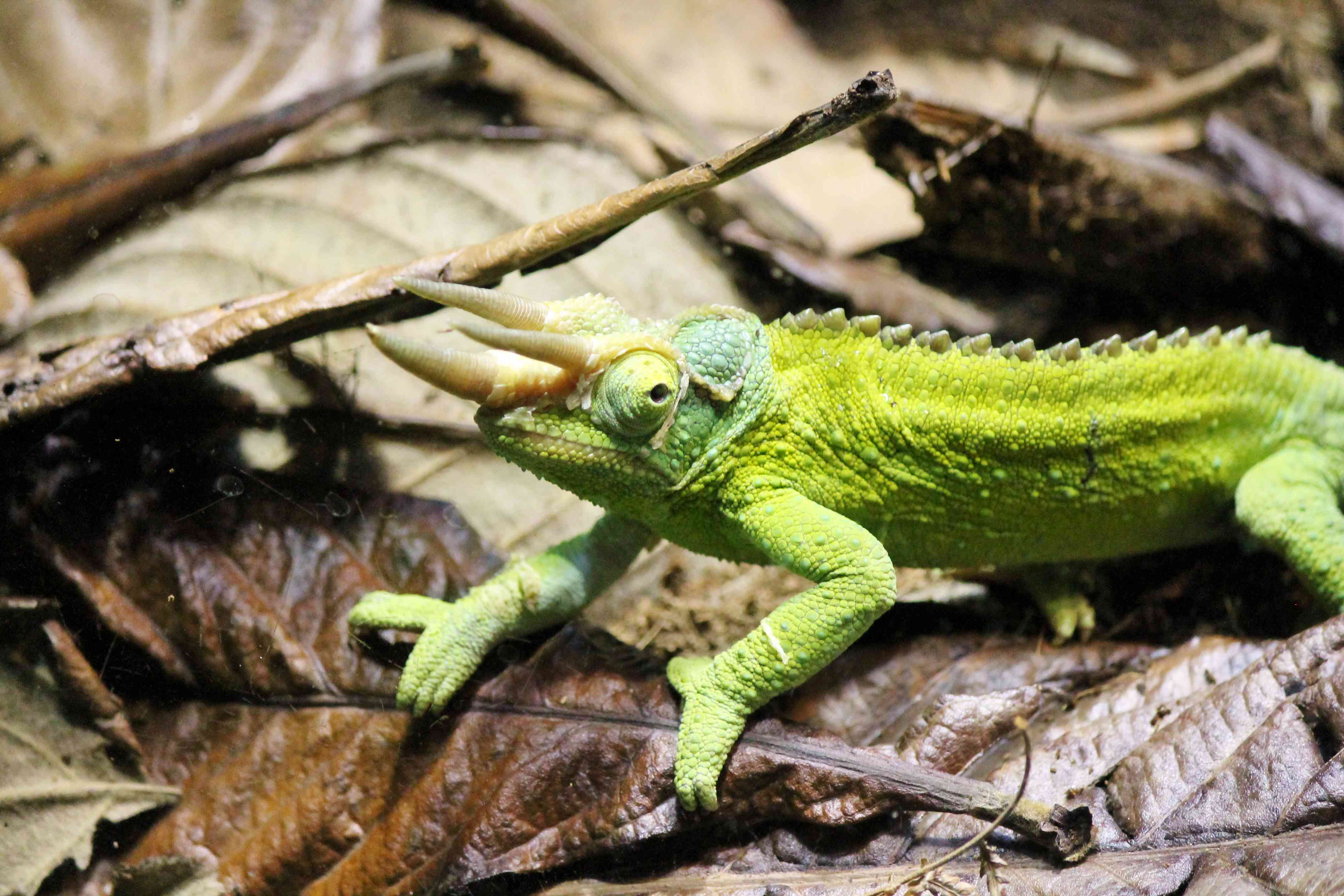
This species is named after its horn-like nose which is particularly apparent in males, and it develops to be somewhere 11 inches long. It has a little spike on its head and a peak that runs roughly halfway down its back.
The Rhino’s coloration is normally bland, primarily gray or pale brown, with a blue-tinted nose and a white stripe running down its flanks.
The Rhinoceros Chameleon is native to western Madagascar and dwells in dry woods. Its environment is endangered by deforestation, and the genus is deemed fragile.
17. African Chameleon
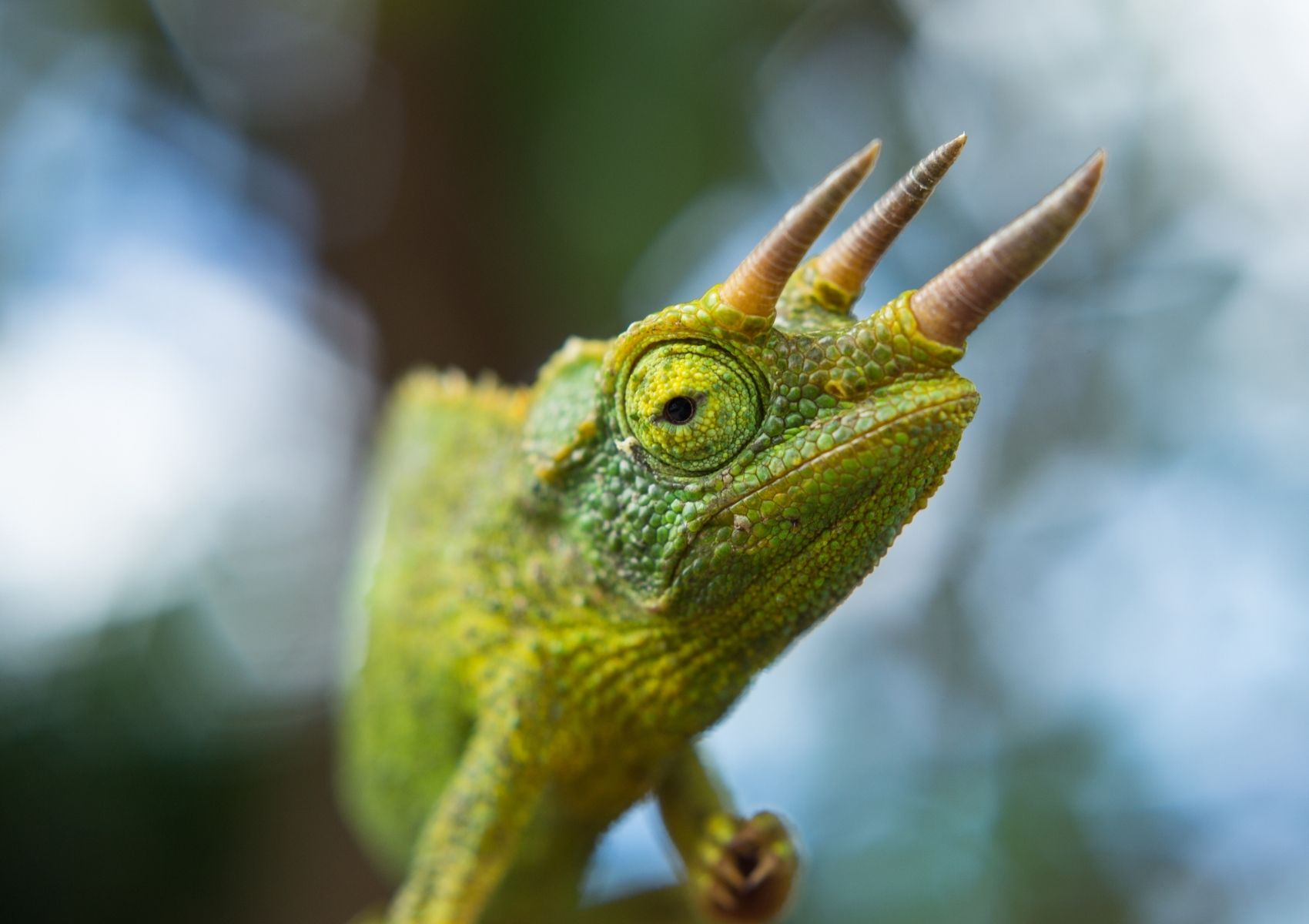
This species, sometimes called the Sahel chameleon, is found only in the arid savannah parts of Africa’s Sahel. This chameleon species can grow to be quite huge, reaching up to 18 inches long. It is often greenish with a smattering of black dots and a big, bone casque on top of its head.
18. Smooth Chameleon
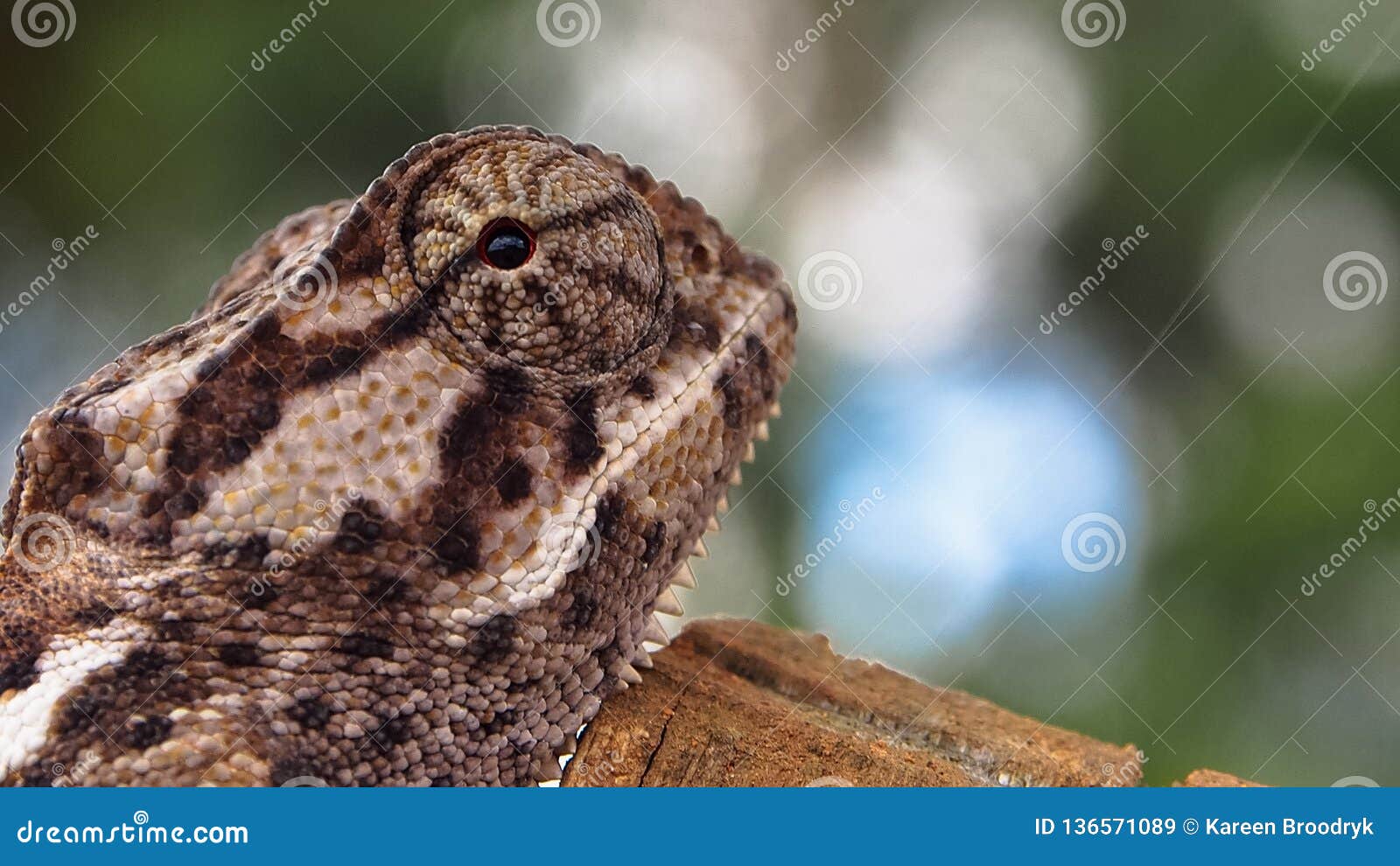
These bluish-greenish chameleon species are found in plains across Sub-Saharan Africa and are unique in that it is relatively skinny in comparison to many other chameleon types.
Genus: Rhampholean
Rhampolean reptiles are native to Africa and are mostly compact.
1. African Leaf Chameleon Marshall’s
This creature, also known as the Marshall’s Leaf Chameleon and the Marshall’s Pygmy Chameleon, is located in Zimbabwe.
It is a little woodland chameleon that grows to be around 1.5 to 3 inches long. It gets its name from the thing that remains stationary on trees and bushes, resembling a leaf.
2. Chameleon Spectral Pygmy
This chameleon species can be found in the jungles and coastal plains of central and western Africa, and it is likewise relatively tiny.
This type, which grows to be around 3 12 inches long, has a high, flattened body structure.
3. Tanzanian Stump-Tail Chameleon
They are often gray or brownish in appearance and are smaller in size.
They lack horns yet have a “rosette-like extension” and spikes that are expanded on their arms and sides. Due to their small size, these chameleons are frequently mistaken for pygmy chameleons.
Genus: Brookesia
Brookesia species are indigenous to Madagascar and are widely recognized as Leaf Chameleons.
They are all rather little, and several of the varieties in this genus have recently been found.
1. Pygmy Thiel
This type, which is also widespread in eastern Madagascar, is quite tiny and blends in well with its thickly wooded environment.
While it is not threatened, there is worry about the species’ survival due to the increasing loss of forest areas in Madagascar.
2. Chameleon Dead Leaf
This chameleon is also known as the Brown Leaf Chameleon. These names are derived from the look of the creature. Their hue — brownish-green, dark red, olive, or mixtures of these – and their tall, flattened bodies do resemble a dead leaf.
These little chameleons are native to eastern Madagascar and possess remarkable horns and spiky scales.
3. Chameleon Mossy Leaves
The Mossy Leaf, also known as the Iaraka River Chameleon, is a one-of-a-kind Madagascar species. The intricate pattern and colors make it clear why this species was named.
4. Armored Leaf Chameleon
The Armored Leaf is also known as the Antsingy Leaf. This Brookesia chameleon is the biggest in the species, reaching lengths of up to 11 cm.
They are brown and spiky, and may readily mix in with the trees on their natural forest ground. It is located in northern Madagascar.
5. Nosy Be Pygmy Chameleon
This type, one of the world’s tiniest four-legged creatures, is one of the most recently found chameleons. The name is derived from the Nosy Be Forest where it lives, and the most noticeable aspect of this jungle chameleon is its little height.
Nosy Be pygmy chameleons develop to be only 12 to slightly more than an inch tall.
6. Leaf Chameleon Antongil
Antongil Leaf chameleons are found in northern Madagascar and are recognized for their small size. As a consequence of deforestation, this species’ numbers have shrunk and grown more scattered. As a result, they are classified as endangered.
7. Decary’s Chameleon
Decary’s chameleons are unique creatures that can only be found in Madagascar. Sadly, the solely recognized population is declining owing to habitat degradation, making these creatures endangered.
Genus: Furcifer
Furcifer chameleons, similar to Brookesia chameleons, are largely native to Madagascar.
1. Chameleon Wills
Wills’ chameleons that are also called Canopy chameleons are often green and white with brownish patterns. It is native to Madagascar and prefers high elevations and mild weather.
2. The Petter’s Chameleon
This type is often bright green with side white stripes and a startling white mouth. They expand around 6 inches long exactly, with females demonstrating particularly impressive color-shifting skills. Males of this genus have a distinct nub projecting from their faces.
This variety is kept as a pet by some individuals, however, it is usually seen to be a good choice only for professional-level reptile lovers.
3. Spiny Chameleon
This genus, often known as the Warty chameleon or the Crocodile chameleon, has a unique casque and tiny spikes extending between its eyes and nose.
This is in contrast to the spines that bear its name that extend along its back. It is typically grayish or brown, with deeper blotchy and a white band running down either side of its body.
4. Angel’s Chameleon
This chameleon variety from northwest Madagascar is generally brown and has a characteristic sharp rise at the front of its skull. Angel’s chameleons frequently have white stripes down the sides of their bodies.
5. Tusked Chameleon
Male Tusked chameleons may grow to be 19 inches long when fully mature. The male individuals’ pointy rostral appendages are what provide this genus its name. The hue and patterning of these chameleons vary, with some being uniform brilliant green and others having black bars.
6. Labord’s Chameleon
The Labord’s chameleon is native to Madagascar’s southwest. The lifetime of this creature is the least of any four-legged animal. This lizard lives for around 4 to 5 months after hatching.
Genus: Calumma
1. The Globe-Horned Chameleon
Flat-Casqued chameleons are another name for Globe-Horned chameleons. They have two globular extensions on the front of their faces that are difficult to discern until you stare at them from the front.
2. Chameleon Malthe
The Malthe chameleon is a species of chameleon native to eastern Madagascar’s highland rainforest and jungles. Males have a big occipital lobe and a nose-like extension. Females have prominent blue patterns encircling the occipital lobes and across the eyelids around the mating process.
3. O’Shaughnessy’s Chameleon
O’Shaughnessy’s chameleon is a species that is native to Madagascar’s central region. It is brown with darker spots around the neck. Males mature to be almost 15 inches long and have a small, bone hump on their noses.
4. Boettger’s Chameleon
This chameleon is also known as the Blue-Nosed chameleon and they develop to be no more than 5 inches. They are often brown, brownish-green, or brownish-yellow in color. Some instances have eye-catching blue dots.
5. Chameleon with Side-Striped Scales
This species, often known as the Perinet chameleon, is distinguished by its vivid green color. Pale stripes traverse the entire body on either side.
6. Parson’s Chameleon
The Parson’s chameleon is one of the biggest chameleon species, with two known subspecies, one of which may grow to reach 27 inches in length.
They come in a variety of colors and have one of the greatest life expectancies of any chameleon. A healthy Parson’s chameleon may survive for about ten years.
7. Short-Horned Chameleon
The occipital lobes of Short-Horned Chameleons are unique, and adults have a bony extension that projects from their snout. They are tiny and generally brownish or grayish, however, there are differences within the genus, some may have bluish legs.
8. Nose-Horned Chameleon
This species is also known as the Big-Nosed chameleon. They are little and are named from the broad nose-like protrusion that protrudes from the front of their face. Experts have also discovered a Peculiar chameleon species within the Calumma genus that is related yet distinct.
Some of the other chamaeleon species present in the wild have previously been listed in the pet species:
- Three Horned Chameleon
- Flap necked Chameleon
- Fischer’s Chameleon
- Mellers Chameleon
- Four-horned Chameleon
- Carpet Chameleon
- Panther Chameleon
- Oustalet’s Chameleon
- Hooded Chameleon
Moreover, if you want to learn about the chameleon diet, click here.
Final Thoughts
There’s a reason these lizards are so well-known. Their distinct appearance, calm demeanor, and simplicity of maintenance make them a no-brainer for both experienced and novice owners.
Veiled, Jackson’s, Ambilobe Panthers, and Flap-Necked chameleons are ideal for first-time owners.
Most Chameleons are better suited to individuals with reptile care expertise.
Having a pet chameleon takes a tremendous lot of consideration, labor, and attention to detail. Yet, for those prepared to take on the task, these colorful reptiles make gratifying and eye-catching lizards.
Do you believe you’re ready to purchase one of these one-of-a-kind lizards? Make sure you conduct a lot of studies to figure out which species is ideal for you.
Comment down below and tell me which of the chameleons you adore the most!
FAQ’s
Chameleons may make great pets in the appropriate conditions, but they aren’t for everyone. This is because chameleons demand a precise maintenance routine with a hands-off attitude. That may be appealing to some potential owners but not to others.
Beautiful lizards. There are some unusual shapes and colors in the reptile world, but chameleons have some of the most remarkable variations. These vibrant lizards are noted for their ability to change color, their long, adhesive tongue, and their eyes, which can rotate freely of one another.
No. Reptiles do not have the emotional centers in their minds that mammals have, thus they cannot interact or communicate with their owners.
Stress may cause chameleons to change dark hues or black, but happy and comfortable chameleons would be brilliant green and blue at home.
Chameleons, like other living beings, do sleep. The length of time they sleep varies according to the type and the season of the year, but overall, they sleep for around twelve hours per night.

